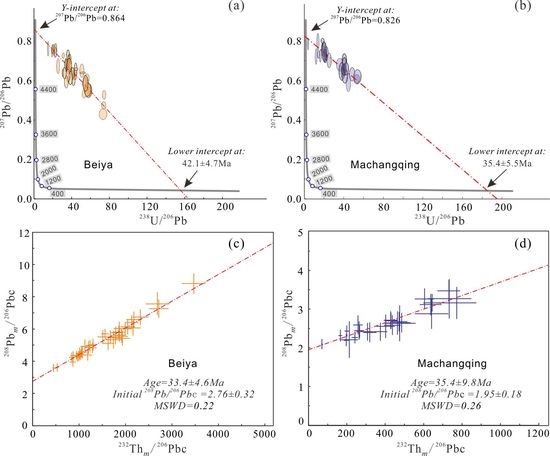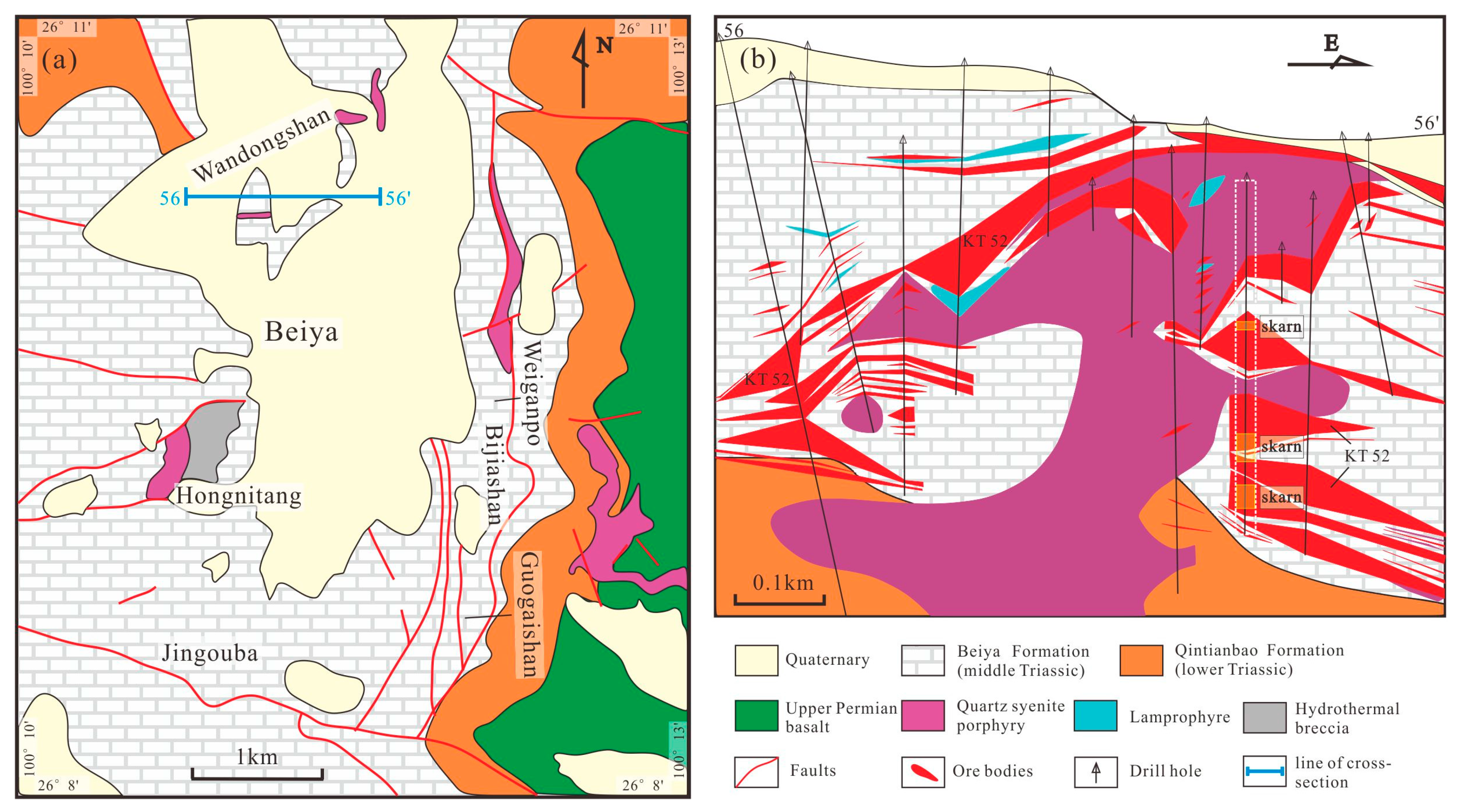LA-ICP-MS U-Th-Pb Dating and Trace Element Geochemistry of Allanite: Implications on the Different Skarn Metallogenesis between the Giant Beiya Au and Machangqing Cu-Mo-(Au) Deposits in Yunnan, SW China
Abstract
:1. Introduction
2. Geological Background
2.1. Regional Geology
2.2. Ore Deposit Geology
2.2.1. Beiya
2.2.2. Machangqing
3. Samples and Analytical Methods
4. Results
4.1. Major and Trace Elements of Allanite
4.2. Allanite U-Th-Pb Ages
5. Discussion
5.1. Reliability of Allanite U-Th-Pb Dating
5.2. Age of Skarn Mineralization in the Beiya and Machangqing Deposits
5.3. Metallogenic Implications
6. Conclusions
- (1)
- Allanite U-Th-Pb geochronology can be obtained by using Th-Pb isochron age and the non-matrix matched external standardization approach.
- (2)
- Allanite from the Beiya and Machangqing Au skarn yielded a Th-Pb isochron ages of 33.4 ± 4.6 Ma (MSWD = 0.22) and 35.4 ± 9.8 Ma (MSWD = 0.26), respectively, representing the ages of the retrograde alteration.
- (3)
- Major and trace element characteristics of the allanite from the two deposits suggest that the ore-forming fluids in the Beiya deposit may have had higher F content and oxygen fugacity than those in the Machangqing deposit.
Acknowledgments
Author Contributions
Conflicts of Interest
Appendix A
| Beiya | |||||||||||||||||||||
| Point | W364-1-01 | W364-1-02 | W364-1-03 | W364-1-04 | W364-1-05 | W364-1-06 | W364-1-07 | W364-1-08 | W364-1-09 | W364-1-10 | W364-1-11 | W364-2-01 | W364-2-02 | W364-2-03 | W364-2-04 | W364-2-05 | W364-2-06 | W364-2-07 | W364-2-08 | W364-2-09 | W364-2-10 |
| MgO | 0.30 | 0.32 | 0.33 | 0.41 | 0.33 | 0.31 | 0.34 | 0.33 | 0.33 | 0.30 | 0.35 | 0.31 | 0.30 | 0.33 | 0.33 | 0.34 | 0.30 | 0.33 | 0.37 | 0.37 | 0.34 |
| Al2O3 | 8.10 | 9.72 | 11.14 | 10.32 | 9.55 | 12.59 | 9.09 | 10.08 | 9.11 | 9.15 | 9.85 | 10.31 | 9.11 | 12.95 | 13.33 | 9.23 | 9.83 | 10.35 | 7.31 | 9.68 | 13.33 |
| SiO2 | 30.59 | 31.32 | 31.82 | 31.19 | 31.51 | 32.73 | 30.97 | 31.84 | 31.02 | 30.74 | 31.35 | 31.96 | 31.64 | 32.89 | 32.79 | 31.89 | 31.42 | 31.49 | 30.94 | 31.23 | 32.58 |
| CaO | 12.06 | 12.82 | 13.69 | 12.77 | 13.40 | 15.05 | 12.73 | 13.83 | 12.59 | 12.16 | 13.11 | 13.81 | 13.28 | 15.78 | 15.61 | 13.32 | 13.38 | 13.48 | 12.44 | 13.16 | 15.92 |
| TiO2 | 0.65 | 0.62 | 0.59 | 0.62 | 0.83 | 0.74 | 0.55 | 0.59 | 0.57 | 0.65 | 0.58 | 0.72 | 0.58 | 0.89 | 0.79 | 0.99 | 0.79 | 0.70 | 0.79 | 0.80 | 0.55 |
| MnO | 0.29 | 0.27 | 0.25 | 0.27 | 0.31 | 0.27 | 0.26 | 0.22 | 0.25 | 0.27 | 0.25 | 0.26 | 0.22 | 0.24 | 0.23 | 0.25 | 0.25 | 0.23 | 0.28 | 0.27 | 0.24 |
| FeOT | 24.15 | 22.53 | 20.69 | 20.79 | 22.37 | 19.23 | 22.49 | 21.92 | 22.66 | 22.27 | 21.81 | 21.61 | 23.12 | 19.21 | 18.19 | 21.85 | 22.16 | 21.31 | 24.21 | 21.50 | 18.41 |
| La2O3 | 9.48 | 8.60 | 8.60 | 8.47 | 8.40 | 7.77 | 8.88 | 8.06 | 9.09 | 9.51 | 9.09 | 8.09 | 8.95 | 6.23 | 6.76 | 8.52 | 8.98 | 8.28 | 8.93 | 8.58 | 6.06 |
| Ce2O3 | 9.60 | 8.46 | 7.98 | 8.30 | 7.45 | 7.08 | 8.71 | 7.83 | 8.83 | 9.30 | 8.69 | 8.25 | 8.54 | 6.75 | 7.41 | 7.71 | 8.45 | 8.06 | 9.01 | 8.19 | 6.83 |
| Pr2O3 | 0.46 | 0.47 | 0.46 | 0.42 | 0.45 | 0.42 | 0.45 | 0.47 | 0.47 | 0.55 | 0.51 | 0.44 | 0.45 | 0.50 | 0.49 | 0.47 | 0.49 | 0.50 | 0.45 | 0.48 | 0.43 |
| Nd2O3 | 0.91 | 0.95 | 0.90 | 0.87 | 1.00 | 0.88 | 0.91 | 0.94 | 0.97 | 1.24 | 1.08 | 0.91 | 0.89 | 1.02 | 0.97 | 0.95 | 1.00 | 1.00 | 0.91 | 0.90 | 0.83 |
| ThO2 | 0.37 | 0.54 | 0.27 | 0.28 | 1.43 | 0.10 | 0.53 | 0.68 | 0.72 | 0.42 | 0.26 | 0.28 | 0.42 | 0.32 | 0.38 | 0.30 | 0.24 | 0.37 | 0.08 | 0.25 | 0.37 |
| F | 0.18 | 0.12 | 0.38 | 0.35 | 0.18 | 0.11 | 0.16 | 0.11 | 0.10 | 0.19 | 0.14 | 0.41 | 0.08 | 0.01 | 0.10 | 0.01 | 0.11 | 0.09 | 0.22 | 0.14 | 0.21 |
| Total | 96.59 | 96.08 | 96.46 | 94.42 | 95.59 | 97.07 | 95.39 | 96.11 | 95.88 | 96.14 | 96.67 | 96.66 | 97.06 | 96.78 | 96.89 | 95.52 | 97.05 | 95.72 | 95.63 | 95.16 | 95.51 |
| Formula Calculation Based on 8 Cations and 12.5 Oxygens | |||||||||||||||||||||
| Mg | 0.04 | 0.05 | 0.05 | 0.06 | 0.05 | 0.04 | 0.05 | 0.05 | 0.05 | 0.04 | 0.05 | 0.04 | 0.04 | 0.04 | 0.04 | 0.05 | 0.04 | 0.05 | 0.05 | 0.05 | 0.05 |
| Al | 0.93 | 1.09 | 1.22 | 1.16 | 1.07 | 1.36 | 1.03 | 1.12 | 1.04 | 1.04 | 1.11 | 1.13 | 1.02 | 1.39 | 1.43 | 1.04 | 1.10 | 1.16 | 0.84 | 1.10 | 1.43 |
| Si | 2.96 | 2.99 | 2.96 | 2.99 | 2.98 | 3.00 | 2.99 | 3.00 | 2.99 | 2.98 | 2.98 | 2.97 | 3.00 | 2.99 | 2.99 | 3.06 | 2.98 | 3.00 | 3.01 | 3.00 | 2.97 |
| Ca | 1.25 | 1.31 | 1.37 | 1.31 | 1.36 | 1.48 | 1.32 | 1.40 | 1.30 | 1.26 | 1.34 | 1.38 | 1.35 | 1.54 | 1.52 | 1.37 | 1.36 | 1.37 | 1.30 | 1.36 | 1.55 |
| Ti | 0.05 | 0.04 | 0.04 | 0.04 | 0.06 | 0.05 | 0.04 | 0.04 | 0.04 | 0.05 | 0.04 | 0.05 | 0.04 | 0.06 | 0.05 | 0.07 | 0.06 | 0.05 | 0.06 | 0.06 | 0.04 |
| Mn | 0.02 | 0.02 | 0.02 | 0.02 | 0.02 | 0.02 | 0.02 | 0.02 | 0.02 | 0.02 | 0.02 | 0.02 | 0.02 | 0.02 | 0.02 | 0.02 | 0.02 | 0.02 | 0.02 | 0.02 | 0.02 |
| Fe2+ | 0.69 | 0.62 | 0.56 | 0.58 | 0.58 | 0.49 | 0.63 | 0.56 | 0.65 | 0.68 | 0.63 | 0.55 | 0.62 | 0.45 | 0.47 | 0.56 | 0.61 | 0.58 | 0.63 | 0.59 | 0.43 |
| Fe3+ | 1.26 | 1.18 | 1.05 | 1.08 | 1.19 | 0.98 | 1.19 | 1.16 | 1.18 | 1.12 | 1.11 | 1.13 | 1.22 | 1.02 | 0.92 | 1.19 | 1.14 | 1.11 | 1.34 | 1.14 | 0.97 |
| La | 0.34 | 0.30 | 0.30 | 0.30 | 0.29 | 0.26 | 0.32 | 0.28 | 0.32 | 0.34 | 0.32 | 0.28 | 0.31 | 0.21 | 0.23 | 0.30 | 0.31 | 0.29 | 0.32 | 0.30 | 0.20 |
| Ce | 0.34 | 0.30 | 0.27 | 0.29 | 0.26 | 0.24 | 0.31 | 0.27 | 0.31 | 0.33 | 0.30 | 0.28 | 0.30 | 0.23 | 0.25 | 0.27 | 0.29 | 0.28 | 0.32 | 0.29 | 0.23 |
| Pr | 0.02 | 0.02 | 0.02 | 0.01 | 0.02 | 0.01 | 0.02 | 0.02 | 0.02 | 0.02 | 0.02 | 0.01 | 0.02 | 0.02 | 0.02 | 0.02 | 0.02 | 0.02 | 0.02 | 0.02 | 0.01 |
| Nd | 0.03 | 0.03 | 0.03 | 0.03 | 0.03 | 0.03 | 0.03 | 0.03 | 0.03 | 0.04 | 0.04 | 0.03 | 0.03 | 0.03 | 0.03 | 0.03 | 0.03 | 0.03 | 0.03 | 0.03 | 0.03 |
| Th | 0.01 | 0.01 | 0.01 | 0.01 | 0.03 | 0.00 | 0.01 | 0.01 | 0.02 | 0.01 | 0.01 | 0.01 | 0.01 | 0.01 | 0.01 | 0.01 | 0.01 | 0.01 | 0.00 | 0.01 | 0.01 |
| F | 0.05 | 0.04 | 0.11 | 0.11 | 0.05 | 0.03 | 0.05 | 0.03 | 0.03 | 0.06 | 0.04 | 0.12 | 0.02 | 0.00 | 0.03 | 0.00 | 0.03 | 0.03 | 0.07 | 0.04 | 0.06 |
| Total | 8.00 | 8.00 | 8.00 | 8.00 | 8.00 | 8.00 | 8.00 | 8.00 | 8.00 | 8.00 | 8.00 | 8.00 | 8.00 | 8.00 | 8.00 | 8.00 | 8.00 | 8.00 | 8.00 | 8.00 | 8.00 |
| Fe3+/(Fe2+ + Fe3+) | 0.65 | 0.65 | 0.65 | 0.65 | 0.67 | 0.67 | 0.65 | 0.67 | 0.64 | 0.62 | 0.64 | 0.67 | 0.66 | 0.70 | 0.66 | 0.68 | 0.65 | 0.66 | 0.68 | 0.66 | 0.69 |
| Machangqing | |||||||||||||||||||||
| Points | JDS03-01A-01 | JDS03-01A-02 | JDS03-01A-03 | JDS03-01A-04 | JDS03-01A-05 | JDS03-01A-06 | JDS03-01A-07 | JDS03-01A-08 | JDS03-01B-01 | JDS03-01B-02 | JDS03-01B-03 | JDS03-01B-04 | JDS03-01B-05 | JDS03-01B-06 | JDS03-01B-07 | JDS03-01B-08 | |||||
| MgO | 0.65 | 0.64 | 0.69 | 0.44 | 0.65 | 0.60 | 0.45 | 0.89 | 0.81 | 0.90 | 0.81 | 0.89 | 0.82 | 0.80 | 0.81 | 0.84 | |||||
| Al2O3 | 11.10 | 13.00 | 12.45 | 10.11 | 8.78 | 12.03 | 10.22 | 8.81 | 8.03 | 10.37 | 12.27 | 8.73 | 8.83 | 9.95 | 8.42 | 10.08 | |||||
| SiO2 | 31.60 | 32.81 | 31.55 | 31.13 | 30.15 | 31.34 | 31.22 | 30.32 | 30.48 | 31.52 | 32.48 | 30.60 | 30.99 | 31.20 | 30.54 | 31.16 | |||||
| CaO | 13.16 | 15.28 | 13.14 | 12.91 | 12.03 | 13.35 | 12.93 | 11.71 | 11.76 | 13.28 | 15.24 | 11.97 | 12.40 | 13.13 | 11.31 | 12.67 | |||||
| TiO2 | 0.68 | 0.60 | 0.61 | 0.55 | 0.60 | 0.29 | 0.73 | 0.63 | 0.79 | 0.96 | 0.63 | 0.80 | 0.90 | 0.69 | 0.62 | 0.46 | |||||
| MnO | 0.16 | 0.14 | 0.15 | 0.17 | 0.21 | 0.14 | 0.25 | 0.17 | 0.20 | 0.25 | 0.21 | 0.23 | 0.24 | 0.29 | 0.20 | 0.30 | |||||
| FeOT | 20.34 | 19.20 | 18.69 | 21.51 | 23.04 | 19.43 | 21.72 | 21.16 | 23.43 | 19.50 | 18.67 | 23.08 | 23.56 | 22.13 | 20.21 | 19.92 | |||||
| La2O3 | 7.59 | 6.18 | 8.15 | 9.59 | 7.61 | 7.48 | 7.47 | 7.48 | 6.83 | 5.65 | 5.72 | 6.20 | 6.04 | 6.40 | 9.58 | 8.09 | |||||
| Ce2O3 | 10.09 | 7.62 | 10.02 | 9.97 | 9.91 | 10.20 | 10.23 | 10.24 | 10.52 | 9.04 | 7.76 | 9.69 | 10.11 | 9.41 | 9.94 | 8.99 | |||||
| Pr2O3 | 0.61 | 0.61 | 0.62 | 0.56 | 0.74 | 0.56 | 0.75 | 0.64 | 0.75 | 0.73 | 0.74 | 0.74 | 0.74 | 0.70 | 0.88 | 0.71 | |||||
| Nd2O3 | 1.40 | 1.38 | 1.39 | 1.29 | 1.90 | 1.23 | 2.12 | 1.61 | 2.36 | 2.30 | 2.20 | 2.20 | 2.00 | 1.98 | 2.88 | 1.87 | |||||
| ThO2 | 0.16 | 0.18 | 0.03 | 0.43 | 0.11 | 0.15 | 0.10 | 0.02 | 0.01 | 0.01 | 0.00 | 0.13 | 0.05 | 0.10 | 0.00 | 0.05 | |||||
| F | 0.38 | 0.00 | 0.16 | 0.11 | 0.13 | 0.05 | 0.12 | 0.28 | 0.15 | 0.10 | 0.00 | 0.14 | 0.14 | 0.13 | 0.12 | 0.20 | |||||
| Total | 97.38 | 97.45 | 97.45 | 98.22 | 95.62 | 96.64 | 98.08 | 93.67 | 95.96 | 94.50 | 96.73 | 95.12 | 96.63 | 96.68 | 95.39 | 95.09 | |||||
| Formula Calculation Based on 8 Cations and 12.5 Oxygens | |||||||||||||||||||||
| Mg | 0.09 | 0.09 | 0.10 | 0.06 | 0.09 | 0.08 | 0.06 | 0.13 | 0.12 | 0.13 | 0.11 | 0.13 | 0.12 | 0.11 | 0.12 | 0.12 | |||||
| Al | 1.22 | 1.39 | 1.37 | 1.13 | 1.01 | 1.34 | 1.14 | 1.02 | 0.92 | 1.17 | 1.33 | 1.00 | 0.99 | 1.11 | 0.99 | 1.15 | |||||
| Si | 2.94 | 2.99 | 2.95 | 2.95 | 2.94 | 2.96 | 2.95 | 2.99 | 2.97 | 3.03 | 3.00 | 2.97 | 2.96 | 2.95 | 3.05 | 3.01 | |||||
| Ca | 1.31 | 1.49 | 1.32 | 1.31 | 1.26 | 1.35 | 1.31 | 1.24 | 1.23 | 1.37 | 1.51 | 1.24 | 1.27 | 1.33 | 1.21 | 1.31 | |||||
| Ti | 0.05 | 0.04 | 0.04 | 0.04 | 0.04 | 0.02 | 0.05 | 0.05 | 0.06 | 0.07 | 0.04 | 0.06 | 0.06 | 0.05 | 0.05 | 0.03 | |||||
| Mn | 0.01 | 0.01 | 0.01 | 0.01 | 0.02 | 0.01 | 0.02 | 0.01 | 0.02 | 0.02 | 0.02 | 0.02 | 0.02 | 0.02 | 0.02 | 0.02 | |||||
| Fe2+ | 0.60 | 0.48 | 0.62 | 0.69 | 0.68 | 0.63 | 0.66 | 0.64 | 0.67 | 0.53 | 0.48 | 0.63 | 0.62 | 0.59 | 0.71 | 0.60 | |||||
| Fe3+ | 0.98 | 0.98 | 0.84 | 1.02 | 1.20 | 0.91 | 1.06 | 1.11 | 1.24 | 1.03 | 0.96 | 1.24 | 1.26 | 1.16 | 0.97 | 1.00 | |||||
| La | 0.26 | 0.21 | 0.28 | 0.34 | 0.27 | 0.26 | 0.26 | 0.27 | 0.25 | 0.20 | 0.19 | 0.22 | 0.21 | 0.22 | 0.35 | 0.29 | |||||
| Ce | 0.34 | 0.25 | 0.34 | 0.35 | 0.35 | 0.35 | 0.35 | 0.37 | 0.38 | 0.32 | 0.26 | 0.34 | 0.35 | 0.33 | 0.36 | 0.32 | |||||
| Pr | 0.02 | 0.02 | 0.02 | 0.02 | 0.03 | 0.02 | 0.03 | 0.02 | 0.03 | 0.03 | 0.02 | 0.03 | 0.03 | 0.02 | 0.03 | 0.02 | |||||
| Nd | 0.05 | 0.04 | 0.05 | 0.04 | 0.07 | 0.04 | 0.07 | 0.06 | 0.08 | 0.08 | 0.07 | 0.08 | 0.07 | 0.07 | 0.10 | 0.06 | |||||
| Th | 0.00 | 0.00 | 0.00 | 0.01 | 0.00 | 0.00 | 0.00 | 0.00 | 0.00 | 0.00 | 0.00 | 0.00 | 0.00 | 0.00 | 0.00 | 0.00 | |||||
| F | 0.11 | 0.00 | 0.05 | 0.03 | 0.04 | 0.02 | 0.04 | 0.09 | 0.05 | 0.03 | 0.00 | 0.04 | 0.04 | 0.04 | 0.04 | 0.06 | |||||
| Total | 8.00 | 8.00 | 8.00 | 8.00 | 8.00 | 8.00 | 8.00 | 8.00 | 8.00 | 8.00 | 8.00 | 8.00 | 8.00 | 8.00 | 8.00 | 8.00 | |||||
| Fe3+/(Fe2+ + Fe3+) | 0.62 | 0.67 | 0.57 | 0.60 | 0.64 | 0.59 | 0.62 | 0.63 | 0.65 | 0.66 | 0.67 | 0.66 | 0.67 | 0.66 | 0.58 | 0.63 | |||||
Appendix B
| Point | Y | La | Ce | Pr | Nd | Sm | Eu | Gd | Tb | Dy | Ho | Er | Tm | Yb | Lu | Pb | Th | U | ΣREE 1 | LREE/HREE 2 | δEu 3 |
|---|---|---|---|---|---|---|---|---|---|---|---|---|---|---|---|---|---|---|---|---|---|
| Beiya | |||||||||||||||||||||
| W364-1-1-1 | 112 | 88,190 | 78,250 | 4031 | 7932 | 434 | 39.8 | 387 | 22.4 | 26.1 | 2.32 | 5.55 | 0.60 | 2.87 | 0.58 | 58.8 | 5584 | 106 | 179,324 | 399 | 0.29 |
| W364-1-1-2 | 197 | 87,032 | 76,961 | 3962 | 7674 | 467 | 42.8 | 394 | 25.1 | 40.2 | 4.36 | 9.71 | 0.95 | 4.86 | 0.98 | 30.3 | 2065 | 112 | 176,619 | 367 | 0.30 |
| W364-1-1-3 | 246 | 90,744 | 81,062 | 4239 | 8510 | 545 | 49.3 | 429 | 28.3 | 49.1 | 5.01 | 11.6 | 1.13 | 5.59 | 1.18 | 34.2 | 3694 | 121 | 185,680 | 349 | 0.30 |
| W364-1-1-4 | 70 | 85,047 | 77,369 | 3975 | 7783 | 365 | 35.6 | 368 | 20.0 | 17.5 | 1.67 | 3.30 | 0.25 | 1.99 | 0.28 | 54.0 | 5638 | 77.7 | 174,988 | 423 | 0.29 |
| W364-1-1-5 | 378 | 71,321 | 64,075 | 3312 | 6620 | 417 | 41.6 | 329 | 23.0 | 50.9 | 6.78 | 22.3 | 2.73 | 15.6 | 3.36 | 43.0 | 4264 | 109 | 146,241 | 321 | 0.33 |
| W364-1-2-1 | 60 | 86,728 | 74,131 | 3860 | 7937 | 389 | 32.0 | 432 | 23.4 | 19.6 | 1.87 | 4.30 | 0.32 | 2.40 | 0.54 | 18.9 | 1283 | 140 | 173,562 | 357 | 0.24 |
| W364-1-2-2 | 152 | 90,608 | 75,867 | 3829 | 7818 | 430 | 40.6 | 449 | 27.3 | 34.4 | 3.76 | 8.90 | 0.80 | 5.28 | 0.78 | 30.5 | 2697 | 210 | 179,121 | 337 | 0.28 |
| W364-1-2-3 | 1125 | 91,277 | 74,072 | 3876 | 8579 | 696 | 78.9 | 521 | 48.2 | 149 | 24.2 | 78.3 | 11.1 | 77.4 | 16.0 | 54.6 | 3922 | 591 | 179,504 | 193 | 0.38 |
| W364-1-2-4 | 888 | 93,501 | 72,101 | 3602 | 7521 | 559 | 56.5 | 476 | 41.5 | 129 | 19.7 | 64.6 | 9.13 | 59.0 | 12.6 | 65.5 | 7621 | 514 | 178,151 | 219 | 0.33 |
| W364-1-2-5 | 274 | 90,340 | 79,374 | 3991 | 8041 | 461 | 43.4 | 465 | 30.3 | 49.6 | 5.70 | 14.4 | 1.54 | 8.69 | 1.71 | 57.8 | 6262 | 100 | 182,827 | 316 | 0.28 |
| W364-1-2-6 | 153 | 86,134 | 77,174 | 4050 | 8276 | 394 | 38.4 | 433 | 25.8 | 31.6 | 3.52 | 8.40 | 0.70 | 4.76 | 0.79 | 46.9 | 6182 | 160 | 176,575 | 346 | 0.28 |
| W364-1-3-1 | 88 | 91,428 | 80,502 | 4061 | 8084 | 456 | 43.6 | 390 | 22.0 | 24.8 | 2.03 | 4.22 | 0.41 | 1.94 | 0.27 | 76.6 | 5855 | 101 | 185,020 | 414 | 0.31 |
| W364-1-3-2 | 184 | 85,556 | 74,594 | 3827 | 7759 | 524 | 49.9 | 378 | 24.0 | 36.7 | 3.99 | 8.05 | 1.05 | 5.62 | 0.97 | 60.5 | 5744 | 174 | 172,768 | 376 | 0.33 |
| W364-1-3-3 | 342 | 61,450 | 53,671 | 2748 | 5644 | 363 | 39.0 | 280 | 19.9 | 46.6 | 7.24 | 21.0 | 2.82 | 16.9 | 3.60 | 41.8 | 3123 | 139 | 124,313 | 311 | 0.36 |
| W364-1-3-4 | 307 | 76,803 | 67,700 | 3595 | 7472 | 510 | 49.8 | 361 | 24.8 | 53.5 | 6.32 | 16.4 | 1.82 | 9.87 | 1.86 | 25.6 | 868 | 117 | 156,606 | 328 | 0.34 |
| W364-1-4-1 | 315 | 83,411 | 74,454 | 3915 | 7774 | 522 | 48.0 | 403 | 27.4 | 51.2 | 6.30 | 16.9 | 2.18 | 11.0 | 2.35 | 69.0 | 3938 | 131 | 170,641 | 327 | 0.31 |
| W364-1-4-2 | 239 | 84,105 | 76,770 | 4035 | 8153 | 556 | 51.0 | 410 | 26.9 | 43.8 | 4.94 | 11.8 | 1.21 | 6.89 | 1.38 | 54.4 | 3564 | 126 | 174,176 | 342 | 0.31 |
| W364-1-4-3 | 239 | 82,493 | 74,052 | 3814 | 7593 | 476 | 45.4 | 391 | 25.1 | 43.4 | 5.09 | 12.4 | 1.46 | 7.29 | 1.62 | 49.7 | 4091 | 147 | 168,960 | 346 | 0.31 |
| W364-1-5-1 | 309 | 93,552 | 81,005 | 4310 | 9329 | 545 | 53.7 | 469 | 31.5 | 57.6 | 7.00 | 18.1 | 2.30 | 14.7 | 2.65 | 39.6 | 4224 | 156 | 189,398 | 313 | 0.32 |
| W364-1-5-2 | 344 | 84,817 | 73,759 | 3885 | 8303 | 498 | 50.6 | 423 | 29.6 | 57.9 | 7.43 | 21.2 | 2.57 | 15.4 | 2.89 | 40.2 | 3189 | 144 | 171,872 | 306 | 0.33 |
| W364-1-5-4 | 1417 | 70,755 | 63,304 | 3435 | 7741 | 566 | 66.2 | 409 | 43.0 | 172 | 31.3 | 103 | 13.3 | 75.2 | 11.7 | 85.5 | 2842 | 220 | 146,724 | 170 | 0.40 |
| W364-1-6-1 | 449 | 91,263 | 77,900 | 3998 | 8317 | 523 | 57.1 | 437 | 31.9 | 68.6 | 9.40 | 27.2 | 3.11 | 19.8 | 4.03 | 38.7 | 2678 | 273 | 182,660 | 303 | 0.36 |
| W364-1-6-2 | 744 | 94,880 | 84,790 | 4660 | 10,633 | 815 | 75.2 | 530 | 45.5 | 126 | 17.8 | 51.1 | 6.27 | 37.0 | 6.75 | 34.6 | 3772 | 137 | 196,673 | 239 | 0.33 |
| W364-1-6-3 | 250 | 93,433 | 82,559 | 4389 | 9236 | 485 | 44.8 | 441 | 28.1 | 47.7 | 5.80 | 15.7 | 1.84 | 11.0 | 2.24 | 39.6 | 4871 | 142 | 190,701 | 343 | 0.29 |
| W364-1-7-1 | 392 | 75,673 | 68,766 | 3703 | 7764 | 535 | 51.4 | 373 | 26.6 | 57.6 | 7.62 | 21.4 | 2.44 | 12.5 | 2.70 | 32.6 | 2251 | 165 | 156,997 | 310 | 0.33 |
| W364-1-7-2 | 204 | 73,150 | 65,767 | 3477 | 7100 | 482 | 49.2 | 341 | 23.0 | 40.1 | 4.60 | 11.0 | 1.01 | 6.54 | 1.30 | 39.3 | 1615 | 178 | 150,455 | 350 | 0.35 |
| W364-1-7-3 | 347 | 75,715 | 67,630 | 3562 | 7495 | 525 | 52.8 | 355 | 25.6 | 55.1 | 7.42 | 21.6 | 2.49 | 14.7 | 3.40 | 49.2 | 4527 | 244 | 155,466 | 319 | 0.35 |
| W364-1-7-6 | 322 | 77,918 | 69,538 | 3710 | 7768 | 537 | 50.5 | 375 | 26.0 | 56.3 | 6.24 | 17.0 | 1.99 | 11.1 | 2.06 | 43.4 | 2484 | 171 | 160,018 | 322 | 0.33 |
| W364-1-7-7 | 355 | 81,574 | 71,970 | 3782 | 7904 | 565 | 60.5 | 387 | 28.1 | 60.8 | 7.73 | 21.2 | 2.41 | 14.1 | 3.29 | 43.9 | 3046 | 265 | 166,380 | 316 | 0.37 |
| W364-2-1-1 | 116 | 83,510 | 71,715 | 3833 | 7621 | 503 | 55.0 | 350 | 14.8 | 33.7 | 3.76 | 6.84 | 0.73 | 4.56 | 0.82 | 16.7 | 3941 | 126 | 167,649 | 403 | 0.38 |
| W364-2-1-2 | 161 | 88,204 | 77,854 | 4300 | 8725 | 589 | 51.6 | 410 | 18.7 | 41.5 | 4.97 | 10.4 | 1.14 | 7.17 | 1.23 | 13.3 | 1901 | 112 | 180,219 | 363 | 0.30 |
| W364-2-1-3 | 125 | 72,795 | 61,568 | 2939 | 6459 | 413 | 43.3 | 299 | 13.1 | 29.6 | 3.75 | 8.82 | 1.19 | 8.78 | 1.30 | 13.3 | 2906 | 95.8 | 144,583 | 394 | 0.36 |
| W364-2-2-2 | 227 | 76,480 | 69,984 | 3913 | 8344 | 616 | 62.6 | 421 | 22.7 | 60.2 | 7.22 | 13.1 | 1.60 | 10.6 | 1.91 | 11.4 | 2288 | 221 | 159,937 | 296 | 0.36 |
| W364-2-3-2 | 240 | 89,916 | 78,004 | 4189 | 8310 | 552 | 60.0 | 404 | 21.1 | 57.9 | 8.90 | 20.3 | 2.95 | 21.7 | 3.78 | 16.9 | 4110 | 207 | 181,571 | 335 | 0.37 |
| W364-2-4-1 | 244 | 86,993 | 76,427 | 4184 | 8527 | 601 | 63.6 | 418 | 21.6 | 57.1 | 8.40 | 20.1 | 2.69 | 18.7 | 3.24 | 21.3 | 3706 | 166 | 177,345 | 322 | 0.37 |
| W364-2-4-2 | 106 | 87,600 | 77,718 | 4246 | 8551 | 547 | 53.5 | 369 | 14.4 | 28.6 | 3.32 | 6.70 | 0.81 | 5.30 | 0.84 | 16.9 | 4022 | 100 | 179,145 | 416 | 0.34 |
| W364-2-7-1 | 471 | 87,816 | 74,173 | 3883 | 7816 | 552 | 62.5 | 415 | 26.4 | 92.3 | 16.2 | 42.4 | 5.79 | 44.6 | 7.66 | 11.5 | 1667 | 158 | 174,953 | 268 | 0.38 |
| W364-2-7-2 | 105 | 83,101 | 71,510 | 3651 | 7135 | 415 | 44.6 | 320 | 13.7 | 29.6 | 3.65 | 8.06 | 1.06 | 5.95 | 1.06 | 14.1 | 2994 | 162 | 166,240 | 433 | 0.36 |
| W364-2-12-1 | 116 | 92,496 | 77,834 | 3923 | 8247 | 507 | 51.2 | 356 | 14.3 | 28.9 | 2.91 | 7.33 | 1.23 | 6.93 | 0.97 | 22.1 | 5393 | 101 | 183,478 | 437 | 0.35 |
| Machangqing | |||||||||||||||||||||
| JDS03-01-01 | 107 | 62,099 | 73,116 | 5212 | 11,996 | 505 | 35.8 | 154 | 10.7 | 27.6 | 3.49 | 7.19 | 0.85 | 3.78 | 0.34 | 18.2 | 2107 | 142 | 153,172 | 735 | 0.30 |
| JDS03-01-02 | 168 | 58,984 | 74,123 | 5619 | 14,018 | 730 | 82.6 | 214 | 15.6 | 43.4 | 5.85 | 11.4 | 1.21 | 4.48 | 0.64 | 14.9 | 1255 | 145 | 153,854 | 517 | 0.49 |
| JDS03-01-03 | 158 | 53,984 | 67,027 | 5469 | 14,304 | 774 | 90.8 | 208 | 14.5 | 44.4 | 5.95 | 11.3 | 1.14 | 6.84 | 0.85 | 11.8 | 1072 | 54.4 | 141,942 | 484 | 0.52 |
| JDS03-01-04 | 98.5 | 59,859 | 72,724 | 5206 | 11,784 | 515 | 45.7 | 152 | 10.4 | 27.4 | 3.44 | 6.88 | 0.69 | 2.88 | 0.30 | 23.5 | 1027 | 114 | 150,337 | 737 | 0.38 |
| JDS03-01-05 | 126 | 57,194 | 71,090 | 5483 | 13,862 | 668 | 78.6 | 166 | 11.8 | 34.5 | 4.91 | 9.20 | 0.88 | 4.98 | 0.53 | 13.9 | 1260 | 54.4 | 148,608 | 637 | 0.52 |
| JDS03-01-06 | 141 | 63,207 | 74,775 | 5313 | 11,943 | 566 | 56.2 | 178 | 13.6 | 38.5 | 5.48 | 9.91 | 0.90 | 4.13 | 0.43 | 21.8 | 1183 | 118 | 156,112 | 621 | 0.42 |
| JDS03-01-07 | 130 | 53,825 | 66,743 | 5092 | 12,867 | 789 | 99.3 | 214 | 15.4 | 42.3 | 5.13 | 9.14 | 0.91 | 5.48 | 0.82 | 11.5 | 1381 | 117 | 139,708 | 476 | 0.55 |
| JDS03-01-08 | 179 | 60,330 | 68,892 | 4776 | 11,043 | 627 | 71.1 | 187 | 15.4 | 46.8 | 6.65 | 13.3 | 1.31 | 6.52 | 0.80 | 11.9 | 1519 | 108 | 146,016 | 525 | 0.49 |
| JDS03-01-09 | 172 | 54,724 | 63,927 | 4614 | 10,898 | 612 | 51.3 | 191 | 15.0 | 45.9 | 5.98 | 11.8 | 1.12 | 5.22 | 0.50 | 14.5 | 1505 | 121 | 135,103 | 488 | 0.36 |
| JDS03-01-10 | 42.2 | 53,263 | 64,195 | 4932 | 11,759 | 508 | 49.1 | 107 | 6.21 | 13.2 | 1.69 | 3.04 | 0.23 | 2.17 | 0.31 | 10.0 | 582 | 30.1 | 134,840 | 1005 | 0.44 |
| JDS03-01-11 | 255 | 62,816 | 79,496 | 6306 | 16,284 | 1040 | 111 | 269 | 23.4 | 70.2 | 9.49 | 20.7 | 2.20 | 11.3 | 1.42 | 8.24 | 847 | 54.1 | 166,460 | 407 | 0.47 |
| JDS03-01-12 | 37.2 | 60,528 | 68,162 | 4827 | 10,524 | 403 | 42.8 | 104 | 5.57 | 13.6 | 1.37 | 2.70 | 0.27 | 0.96 | 0.17 | 7.87 | 406 | 39.5 | 144,614 | 1127 | 0.47 |
| JDS03-01-13 | 35.2 | 59,013 | 72,146 | 5297 | 11,863 | 429 | 41.7 | 96.1 | 4.71 | 10.7 | 1.42 | 2.77 | 0.24 | 1.52 | 0.27 | 28.7 | 465 | 23.5 | 148,909 | 1263 | 0.44 |
| JDS03-01-15 | 192 | 58,306 | 74,330 | 5875 | 14,833 | 881 | 106 | 225 | 18.4 | 55.6 | 7.36 | 13.9 | 1.44 | 8.01 | 0.92 | 12.3 | 714 | 54.5 | 154,662 | 467 | 0.53 |
| JDS03-01-21 | 41.8 | 61,777 | 73,417 | 5049 | 10,791 | 391 | 35.4 | 94.7 | 5.62 | 12.7 | 1.68 | 2.89 | 0.23 | 1.50 | 0.18 | 7.55 | 613 | 37.1 | 151,580 | 1267 | 0.40 |
| JDS03-01-23 | 206 | 58,679 | 72,480 | 5706 | 14,364 | 795 | 82.4 | 203 | 17.1 | 54.4 | 7.50 | 15.2 | 1.79 | 8.49 | 0.99 | 12.4 | 763 | 52.7 | 152,415 | 493 | 0.46 |
| JDS03-01-24 | 70.6 | 57,302 | 68,367 | 4967 | 11,583 | 470 | 47.2 | 116 | 8.26 | 22.0 | 2.59 | 5.98 | 0.52 | 3.03 | 0.43 | 16.5 | 606 | 49.4 | 142,894 | 899 | 0.45 |
| JDS03-01-25 | 41.6 | 62,297 | 72,666 | 5141 | 11,029 | 324 | 33.3 | 81.1 | 4.95 | 12.6 | 1.49 | 3.31 | 0.35 | 1.30 | 0.19 | 7.68 | 560 | 26.5 | 151,597 | 1439 | 0.46 |
| JDS03-01-27 | 532 | 60,070 | 77,383 | 6404 | 18,150 | 1442 | 166 | 422 | 42.8 | 138 | 19.8 | 40.7 | 4.48 | 23.5 | 2.67 | 7.22 | 906 | 89.1 | 164,308 | 236 | 0.50 |
| JDS03-01-28 | 451 | 60,173 | 78,770 | 6682 | 19,085 | 1393 | 128 | 387 | 37.7 | 125 | 16.7 | 34.3 | 3.95 | 16.7 | 2.24 | 6.36 | 859 | 80.0 | 166,854 | 267 | 0.40 |
| JDS03-01-29 | 327 | 59,457 | 76,180 | 6194 | 16,993 | 1124 | 130 | 308 | 28.7 | 90.5 | 11.8 | 24.4 | 2.62 | 13.0 | 1.64 | 6.96 | 832 | 71.2 | 160,560 | 333 | 0.51 |
| JDS03-01-30 | 148 | 60,324 | 72,523 | 5317 | 13,111 | 638 | 82.8 | 165 | 13.0 | 39.6 | 5.28 | 10.7 | 1.06 | 6.45 | 0.82 | 7.58 | 739 | 72.9 | 152,238 | 628 | 0.57 |
| JDS03-01-31 | 307 | 62,877 | 74,996 | 5501 | 14,073 | 885 | 108 | 262 | 24.2 | 80.3 | 11.2 | 23.4 | 2.54 | 13.3 | 1.66 | 8.84 | 825 | 86.9 | 158,859 | 378 | 0.53 |
| JDS03-01-32 | 244 | 60,304 | 73,398 | 5487 | 13,750 | 814 | 93.8 | 224 | 20.2 | 64.9 | 8.53 | 17.3 | 1.83 | 7.64 | 1.01 | 8.33 | 747 | 102 | 154,193 | 446 | 0.50 |
| JDS03-01-33 | 248 | 59,246 | 73,606 | 5699 | 14,554 | 875 | 88.9 | 232 | 21.1 | 68.5 | 9.33 | 18.2 | 1.85 | 9.76 | 1.24 | 14.3 | 637 | 72.3 | 154,431 | 426 | 0.45 |
| JDS03-01-34 | 321 | 42,699 | 54,658 | 4467 | 12,219 | 873 | 112 | 248 | 24.2 | 83.8 | 11.0 | 23.4 | 2.58 | 14.3 | 1.57 | 8.03 | 547 | 89.6 | 115,437 | 282 | 0.56 |
| JDS03-01-37 | 251 | 56,208 | 67,943 | 5361 | 13,328 | 831 | 109 | 231 | 20.3 | 67.9 | 9.15 | 18.4 | 1.83 | 8.97 | 1.22 | 9.04 | 723 | 102 | 144,140 | 401 | 0.57 |
Appendix C
| Point | Measured Value | 207Pb Correction | ||||||||||
|---|---|---|---|---|---|---|---|---|---|---|---|---|
| Th/U | 207Pb/206Pb | 207Pb/235U | 206Pb/238U | 208Pb/232Th | f206 | 232Thm/206Pbc | 208Pbm/206Pbc | |||||
| Ratio | 1sigma | Ratio | 1sigma | Ratio | 1sigma | Ratio | 1sigma | |||||
| Beiya | ||||||||||||
| W364-1-1-1 | 52.4 | 0.7431 | 0.0215 | 4.4970 | 0.1902 | 0.0439 | 0.0016 | 0.0032 | 0.0001 | 0.85 | 1788 | 5.8 |
| W364-1-1-2 | 18.4 | 0.6715 | 0.0243 | 2.6101 | 0.0924 | 0.0282 | 0.0008 | 0.0043 | 0.0001 | 0.76 | 1052 | 4.6 |
| W364-1-1-3 | 30.5 | 0.6563 | 0.0303 | 2.0378 | 0.0821 | 0.0225 | 0.0005 | 0.0029 | 0.0000 | 0.75 | 2319 | 6.7 |
| W364-1-1-4 | 72.5 | 0.7589 | 0.0307 | 5.2115 | 0.1907 | 0.0498 | 0.0015 | 0.0030 | 0.0000 | 0.87 | 2129 | 6.4 |
| W364-1-1-5 | 39.2 | 0.7262 | 0.0246 | 3.2016 | 0.0950 | 0.0320 | 0.0009 | 0.0031 | 0.0001 | 0.83 | 1855 | 5.8 |
| W364-1-2-1 | 9.2 | 0.6107 | 0.0292 | 1.4945 | 0.0556 | 0.0177 | 0.0005 | 0.0046 | 0.0001 | 0.69 | 946 | 4.4 |
| W364-1-2-2 | 12.8 | 0.5440 | 0.0232 | 1.2708 | 0.0463 | 0.0169 | 0.0004 | 0.0037 | 0.0001 | 0.61 | 1557 | 5.7 |
| W364-1-2-3 | 6.6 | 0.5277 | 0.0172 | 0.9780 | 0.0317 | 0.0134 | 0.0002 | 0.0043 | 0.0001 | 0.59 | 1072 | 4.6 |
| W364-1-2-4 | 14.8 | 0.4751 | 0.0185 | 0.8848 | 0.0287 | 0.0135 | 0.0003 | 0.0028 | 0.0001 | 0.52 | 2687 | 7.6 |
| W364-1-2-5 | 62.8 | 0.7554 | 0.0290 | 4.9157 | 0.2147 | 0.0472 | 0.0017 | 0.0030 | 0.0001 | 0.87 | 1990 | 6.0 |
| W364-1-2-6 | 38.6 | 0.6497 | 0.0295 | 1.7593 | 0.0796 | 0.0196 | 0.0006 | 0.0025 | 0.0001 | 0.74 | 3466 | 8.8 |
| W364-1-3-1 | 57.8 | 0.7611 | 0.0293 | 6.8840 | 0.3134 | 0.0656 | 0.0021 | 0.0037 | 0.0001 | 0.87 | 1289 | 4.8 |
| W364-1-3-2 | 33.0 | 0.7147 | 0.0295 | 2.7180 | 0.1356 | 0.0276 | 0.0009 | 0.0032 | 0.0001 | 0.82 | 1866 | 6.0 |
| W364-1-3-3 | 22.4 | 0.6777 | 0.0311 | 2.7394 | 0.1124 | 0.0293 | 0.0008 | 0.0040 | 0.0001 | 0.77 | 1233 | 5.0 |
| W364-1-3-4 | 7.4 | 0.6689 | 0.0369 | 2.4998 | 0.1344 | 0.0271 | 0.0011 | 0.0080 | 0.0003 | 0.76 | 450 | 3.6 |
| W364-1-4-1 | 30.0 | 0.7466 | 0.0278 | 5.2608 | 0.1728 | 0.0511 | 0.0012 | 0.0050 | 0.0001 | 0.86 | 870 | 4.3 |
| W364-1-4-2 | 28.3 | 0.7603 | 0.0241 | 4.5014 | 0.1703 | 0.0429 | 0.0013 | 0.0044 | 0.0001 | 0.87 | 964 | 4.3 |
| W364-1-4-3 | 27.8 | 0.6389 | 0.0238 | 2.8627 | 0.0860 | 0.0325 | 0.0007 | 0.0037 | 0.0001 | 0.72 | 1508 | 5.5 |
| W364-1-5-1 | 27.1 | 0.6280 | 0.0302 | 2.0604 | 0.0826 | 0.0238 | 0.0008 | 0.0030 | 0.0001 | 0.71 | 2046 | 6.1 |
| W364-1-5-2 | 22.2 | 0.6842 | 0.0284 | 2.6896 | 0.1098 | 0.0285 | 0.0009 | 0.0039 | 0.0001 | 0.78 | 1298 | 5.0 |
| W364-1-5-4 | 12.9 | 0.6390 | 0.0227 | 2.1352 | 0.0846 | 0.0242 | 0.0007 | 0.0046 | 0.0001 | 0.72 | 866 | 3.9 |
| W364-1-6-1 | 9.8 | 0.5325 | 0.0224 | 1.3792 | 0.0513 | 0.0188 | 0.0005 | 0.0044 | 0.0001 | 0.59 | 1126 | 4.9 |
| W364-1-6-2 | 27.6 | 0.6289 | 0.0300 | 1.9941 | 0.0802 | 0.0230 | 0.0007 | 0.0030 | 0.0001 | 0.71 | 2181 | 6.6 |
| W364-1-6-3 | 34.3 | 0.6041 | 0.0275 | 1.9778 | 0.0823 | 0.0237 | 0.0006 | 0.0027 | 0.0001 | 0.68 | 2715 | 7.3 |
| W364-1-7-1 | 13.7 | 0.6579 | 0.0405 | 2.0285 | 0.0613 | 0.0224 | 0.0007 | 0.0043 | 0.0001 | 0.75 | 1033 | 4.4 |
| W364-1-7-2 | 9.1 | 0.7118 | 0.0272 | 2.6038 | 0.1056 | 0.0265 | 0.0009 | 0.0069 | 0.0002 | 0.81 | 528 | 3.6 |
| W364-1-7-3 | 18.6 | 0.6393 | 0.0316 | 1.7007 | 0.0600 | 0.0193 | 0.0007 | 0.0033 | 0.0001 | 0.73 | 1671 | 5.5 |
| W364-1-7-6 | 14.5 | 0.6982 | 0.0290 | 2.5858 | 0.0963 | 0.0269 | 0.0006 | 0.0050 | 0.0001 | 0.80 | 841 | 4.2 |
| W364-1-7-7 | 11.5 | 0.5876 | 0.0323 | 1.4915 | 0.0642 | 0.0184 | 0.0005 | 0.0040 | 0.0001 | 0.66 | 1203 | 4.9 |
| W364-2-1-1 | 31.4 | 0.6137 | 0.0451 | 2.1871 | 0.1187 | 0.0258 | 0.0010 | 0.0028 | 0.0001 | 0.69 | 2158 | 6.1 |
| W364-2-1-2 | 17.0 | 0.6762 | 0.0521 | 2.4868 | 0.1418 | 0.0267 | 0.0012 | 0.0044 | 0.0002 | 0.77 | 991 | 4.3 |
| W364-2-1-3 | 30.3 | 0.6261 | 0.0485 | 2.3814 | 0.1233 | 0.0276 | 0.0011 | 0.0031 | 0.0001 | 0.71 | 1778 | 5.5 |
| W364-2-2-2 | 10.4 | 0.4296 | 0.0424 | 0.8075 | 0.0450 | 0.0136 | 0.0005 | 0.0031 | 0.0001 | 0.47 | 1742 | 5.3 |
| W364-2-3-2 | 19.9 | 0.5501 | 0.0513 | 1.3131 | 0.0786 | 0.0173 | 0.0007 | 0.0028 | 0.0001 | 0.62 | 1932 | 5.4 |
| W364-2-4-1 | 22.3 | 0.5933 | 0.0325 | 2.3791 | 0.1206 | 0.0291 | 0.0011 | 0.0037 | 0.0001 | 0.67 | 1186 | 4.4 |
| W364-2-4-2 | 40.1 | 0.6376 | 0.0389 | 2.7007 | 0.1291 | 0.0307 | 0.0012 | 0.0030 | 0.0001 | 0.72 | 1868 | 5.6 |
| W364-2-7-1 | 10.6 | 0.5551 | 0.0405 | 1.3432 | 0.0771 | 0.0176 | 0.0007 | 0.0044 | 0.0002 | 0.62 | 1007 | 4.5 |
| W364-2-7-2 | 18.4 | 0.5863 | 0.0372 | 1.4736 | 0.0815 | 0.0182 | 0.0006 | 0.0031 | 0.0001 | 0.66 | 1622 | 5.1 |
| W364-2-12-1 | 53.4 | 0.6725 | 0.0468 | 3.6073 | 0.1912 | 0.0389 | 0.0015 | 0.0029 | 0.0001 | 0.77 | 1912 | 5.5 |
| Machangqing | ||||||||||||
| JDS03-01-01 | 14.8 | 0.6794 | 0.0435 | 2.5978 | 0.1797 | 0.0277 | 0.0017 | 0.0049 | 0.0002 | 0.81 | 637 | 3.1 |
| JDS03-01-02 | 8.7 | 0.6517 | 0.0409 | 2.2412 | 0.1120 | 0.0249 | 0.0010 | 0.0063 | 0.0002 | 0.78 | 429 | 2.7 |
| JDS03-01-03 | 19.7 | 0.7366 | 0.0517 | 4.9660 | 0.2615 | 0.0489 | 0.0024 | 0.0059 | 0.0002 | 0.89 | 437 | 2.6 |
| JDS03-01-04 | 9.0 | 0.7316 | 0.0300 | 4.8846 | 0.2934 | 0.0484 | 0.0023 | 0.0121 | 0.0006 | 0.88 | 200 | 2.4 |
| JDS03-01-05 | 23.1 | 0.7242 | 0.0383 | 6.0529 | 0.3078 | 0.0606 | 0.0025 | 0.0063 | 0.0002 | 0.87 | 430 | 2.7 |
| JDS03-01-06 | 10.0 | 0.7355 | 0.0355 | 4.5322 | 0.2960 | 0.0447 | 0.0025 | 0.0094 | 0.0004 | 0.88 | 241 | 2.3 |
| JDS03-01-07 | 11.8 | 0.5890 | 0.0361 | 1.8097 | 0.1118 | 0.0223 | 0.0008 | 0.0047 | 0.0002 | 0.70 | 731 | 3.5 |
| JDS03-01-08 | 14.1 | 0.6430 | 0.0343 | 2.2538 | 0.1119 | 0.0254 | 0.0009 | 0.0049 | 0.0002 | 0.77 | 644 | 3.2 |
| JDS03-01-09 | 12.4 | 0.6451 | 0.0393 | 2.3189 | 0.1622 | 0.0261 | 0.0014 | 0.0054 | 0.0003 | 0.77 | 604 | 3.3 |
| JDS03-01-10 | 19.4 | 0.7950 | 0.0513 | 7.8032 | 0.5084 | 0.0712 | 0.0039 | 0.0101 | 0.0006 | 0.96 | 258 | 2.6 |
| JDS03-01-11 | 15.7 | 0.7014 | 0.0875 | 3.8173 | 0.2505 | 0.0395 | 0.0022 | 0.0055 | 0.0002 | 0.84 | 475 | 2.6 |
| JDS03-01-12 | 10.3 | 0.7598 | 0.1126 | 5.3281 | 0.3943 | 0.0509 | 0.0034 | 0.0104 | 0.0005 | 0.92 | 213 | 2.2 |
| JDS03-01-13 | 19.8 | 0.7851 | 0.0346 | 30.0247 | 1.7873 | 0.2774 | 0.0149 | 0.0300 | 0.0014 | 0.95 | 70 | 2.1 |
| JDS03-01-15 | 13.1 | 0.7624 | 0.0344 | 5.4323 | 0.2286 | 0.0517 | 0.0017 | 0.0091 | 0.0003 | 0.92 | 266 | 2.4 |
| JDS03-01-21 | 16.5 | 0.7243 | 0.0607 | 4.6693 | 0.2559 | 0.0468 | 0.0021 | 0.0063 | 0.0002 | 0.87 | 402 | 2.6 |
| JDS03-01-23 | 14.5 | 0.8001 | 0.0529 | 5.9012 | 0.3253 | 0.0535 | 0.0029 | 0.0093 | 0.0006 | 0.97 | 264 | 2.4 |
| JDS03-01-24 | 12.3 | 0.7208 | 0.0328 | 8.2259 | 0.5142 | 0.0828 | 0.0042 | 0.0139 | 0.0008 | 0.87 | 166 | 2.3 |
| JDS03-01-25 | 21.2 | 0.7306 | 0.0548 | 6.8960 | 0.3877 | 0.0685 | 0.0037 | 0.0075 | 0.0003 | 0.88 | 320 | 2.4 |
| JDS03-01-27 | 10.2 | 0.6055 | 0.0708 | 1.5633 | 0.0763 | 0.0187 | 0.0008 | 0.0045 | 0.0001 | 0.72 | 734 | 3.3 |
| JDS03-01-28 | 10.7 | 0.6189 | 0.0610 | 1.5807 | 0.0933 | 0.0185 | 0.0008 | 0.0041 | 0.0001 | 0.73 | 772 | 3.2 |
| JDS03-01-29 | 11.7 | 0.6254 | 0.0634 | 2.0887 | 0.1292 | 0.0242 | 0.0011 | 0.0045 | 0.0001 | 0.74 | 641 | 2.9 |
| JDS03-01-30 | 10.1 | 0.7000 | 0.0472 | 2.3727 | 0.1200 | 0.0246 | 0.0009 | 0.0054 | 0.0002 | 0.84 | 486 | 2.6 |
| JDS03-01-31 | 9.5 | 0.6785 | 0.0565 | 2.2885 | 0.1120 | 0.0245 | 0.0008 | 0.0057 | 0.0002 | 0.81 | 463 | 2.6 |
| JDS03-01-32 | 7.4 | 0.6309 | 0.0435 | 1.7893 | 0.0918 | 0.0206 | 0.0008 | 0.0057 | 0.0002 | 0.75 | 472 | 2.7 |
| JDS03-01-33 | 8.8 | 0.7459 | 0.0366 | 5.0596 | 0.4480 | 0.0492 | 0.0038 | 0.0111 | 0.0009 | 0.90 | 197 | 2.2 |
| JDS03-01-34 | 6.1 | 0.6548 | 0.0456 | 2.2208 | 0.1114 | 0.0246 | 0.0010 | 0.0079 | 0.0003 | 0.78 | 307 | 2.4 |
| JDS03-01-37 | 7.1 | 0.6593 | 0.0466 | 2.1331 | 0.1032 | 0.0235 | 0.0009 | 0.0065 | 0.0002 | 0.79 | 374 | 2.4 |
References
- Cox, R.A.; Wilton, D.H.C.; Kosler, J. Laser-ablation U-Th-Pb in situ dating of zircon and allanite: An example from the October Harbour granite, Central Coastal Labrador, Canada. Can. Mineral. 2003, 41, 273–291. [Google Scholar] [CrossRef]
- Cenki-tok, B.; Oliot, E.; Rubatto, D.; Berger, A.; Engi, M.; Janots, E.; Thomsen, T.B.; Manzotti, P.; Regis, D.; Spandler, C.; et al. Preservation of Permian allanite within an Alpine eclogite facies shear zone at Mt Mucrone, Italy: Mechanical and chemical behavior of allanite during mylonitization. Lithos 2011, 125, 40–50. [Google Scholar] [CrossRef]
- Janots, E.; Negro, F.; Brunet, F.; Goffé, B.; Engi, M.; Bouybaouène, M.L. Evolution of the REE mineralogy in HP-LT metapelites of the Sebtide complex, Rif, Morocco: Monazite stability and geochronology. Lithos 2006, 87, 214–234. [Google Scholar] [CrossRef]
- Gregory, C.J.; Rubatto, D.; Allen, C.M.; Williams, I.S.; Hermann, J.; Ireland, T. Allanite micro-geochronology: A LA-ICP-MS and SHRIMP U-Th-Pb study. Chem. Geol. 2007, 245, 162–182. [Google Scholar] [CrossRef]
- Kim, Y.; Cheong, C.-S.; Lee, Y.; Williams, I.S. SHRIMP allanite U-Th-Pb dating of bimodal Triassic metamorphism of Neoarchean tonalitic gneisses, Daeijak Island, central Korea. Geosci. J. 2009, 13, 305–315. [Google Scholar] [CrossRef]
- Jung, S.; Brandt, S.; Nebel, O.; Hellebrand, E.; Seth, B.; Jung, C. The P-T-t paths of high-grade gneisses, Kaoko Belt, Namibia: Constraints from mineral data, U-Pb allanite and monazite and Sm-Nd/Lu-Hf garnet ages and garnet ion probe data. Gondwana Res. 2014, 25, 775–796. [Google Scholar] [CrossRef]
- Cliff, R.A.; Oberli, F.; Meier, M.; Droop, G.T.R.; Kelly, M. Syn-metamorphic folding in the Tauern Window, Austria dated by Th-Pb ages from individual allanite porphyroblasts. J. Metamorph. Geol. 2015, 33, 427–435. [Google Scholar] [CrossRef]
- Janots, E.; Engi, M.; Rubatto, D.; Berger, A.; Gregory, C.; Rahn, M. Metamorphic rates in collisional orogeny from in situ allanite and monazite dating. Geology 2009, 37, 11–14. [Google Scholar] [CrossRef]
- Gregory, C.J.; Rubatto, D.; Hermann, J.; Berger, A.; Engi, M. Allanite behaviour during incipient melting in the southern Central Alps. Geochim. Cosmochim. Acta 2012, 84, 433–458. [Google Scholar] [CrossRef]
- Rubatto, D.; Regis, D.; Hermann, J.; Boston, K.; Engi, M.; Beltrando, M.; Mcalpine, S.R.B. Yo-yo subduction recorded by accessory minerals in the Italian Western Alps. Nat. Geosci. 2011, 4, 338–342. [Google Scholar] [CrossRef]
- Deng, X.; Li, J.; Wen, G. Dating iron skarn mineralization using hydrothermal allanite-(La) U-Th-Pb isotopes by laser ablation ICP-MS. Chem. Geol. 2014, 382, 95–110. [Google Scholar] [CrossRef]
- Chen, T.W.; Zhou, M.-F. Ages and compositions of primary and secondary allanite from the Lala Fe-Cu deposit, SW China: Implications for multiple episodes of hydrothermal events. Contrib. Mineral. Petrol. 2014, 168, 1043. [Google Scholar] [CrossRef]
- Pal, D.C.; Chaudhuri, T.; McFarlane, C.; Mukherjee, A.; Sarangi, A.K. Mineral chemistry and in situ dating of allanite, and geochemistry of its host rocks in the Bagjata uranium mine, Singhbhum Shear Zone, India- Implications for the chemical evolution of REE mineralization and mobilization. Econ. Geol. 2011, 106, 1155–1171. [Google Scholar] [CrossRef]
- Darling, J.R.; Storey, C.D.; Engi, M. Allanite U-Th-Pb geochronology by laser ablation ICPMS. Chem. Geol. 2012, 292, 103–115. [Google Scholar] [CrossRef]
- Janots, E.; Rubatto, D. U-Th-Pb dating of collision in the external Alpine domains (Urseren zone, Switzerland) using low temperature allanite and monazite. Lithos 2014, 184, 155–166. [Google Scholar] [CrossRef]
- Smye, A.J.; Roberts, N.M.W.; Condon, D.J.; Horstwood, M.S.A.; Parrish, R.R. Characterising the U-Th-Pb systematics of allanite by ID and LA-ICPMS: Implications for geochronology. Geochim. Cosmochim. Acta 2014, 135, 1–28. [Google Scholar] [CrossRef]
- Guo, H.; Xiao, Y.; Xu, L.; Sun, H.; Huang, J.; Hou, Z. Origin of allanite in gneiss and granite in the Dabie orogenic belt, Central East China. J. Asian Earth Sci. 2017, 135, 243–256. [Google Scholar] [CrossRef]
- Mcfarlane, C.R.M. Allanite U-Pb geochronology by 193 nm LA ICP-MS using NIST610 glass for external calibration. Chem. Geol. 2016, 438, 91–102. [Google Scholar] [CrossRef]
- He, Z.H.; Guan, D.R.; He, W.Y.; Zhou, Y.M.; Fu, D.G.; Yang, S.; Wang, L.; Li, W.H.; Su, G.S.; Yang, R. Exploration moldel of Beiya superlarge gold-polymetallic deposit, northwestern Yunnan. Miner. Depos. 2016, 35, 261–282. [Google Scholar]
- Mao, J.; Zhou, Y.; Liu, H.; Zhang, C.; Fu, D.; Liu, B. Metallogenic setting and ore genetic model for the Beiya porphyry-skarn polymetallic Au orefield, western Yunnan, China. Ore Geol. Rev. 2017, 86, 21–34. [Google Scholar] [CrossRef]
- Deng, J.; Wang, Q.; Li, G.; Santosh, M. Cenozoic tectono-magmatic and metallogenic processes in the Sanjiang region, southwestern China. Earth-Sci. Rev. 2014, 138, 268–299. [Google Scholar] [CrossRef]
- Deng, X.D.; Li, J.W.; Zhou, M.F.; Zhao, X.F.; Yan, D.R. In-situ LA-ICPMS trace elements and U-Pb analysis of titanite from the Mesozoic Ruanjiawan W-Cu-Mo skarn deposit, Daye district, China. Ore Geol. Rev. 2015, 65, 990–1004. [Google Scholar] [CrossRef]
- Hou, Z.; Zeng, P.; Gao, Y.; Du, A.; Fu, D. Himalayan Cu-Mo-Au mineralization in the eastern Indo-Asian collision zone: Constraints from Re-Os dating of molybdenite. Miner. Depos. 2006, 41, 33–45. [Google Scholar] [CrossRef]
- Fu, Y.; Sun, X.; Lin, H.; Zhou, H.; Li, X.; Ouyang, X.; Jiang, L.; Shi, G.; Liang, Y. Geochronology of the giant Beiya gold-polymetallic deposit in Yunnan Province, Southwest China and its relationship with the petrogenesis of alkaline porphyry. Ore Geol. Rev. 2015, 71, 138–149. [Google Scholar] [CrossRef]
- Deng, J.; Wang, Q.; Li, G.; Hou, Z.; Jiang, C.; Danyushevsky, L. Geology and genesis of the giant Beiya porphyry-skarn gold deposit, northwestern Yangtze Block, China. Ore Geol. Rev. 2015, 70, 457–485. [Google Scholar] [CrossRef]
- Liu, B.; Liu, H.; Zhang, C.; Mao, Z.; Zhou, Y.; Huang, H.; He, Z.; Su, G. Geochemistry and geochronology of porphyries from the Beiya gold-polymetallic orefield, western Yunnan, China. Ore Geol. Rev. 2015, 69, 360–379. [Google Scholar] [CrossRef]
- Fu, Y.; Sun, X.; Zhou, H.; Lin, H.; Jiang, L.; Yang, T. In-situ LA-ICP-MS trace elements analysis of scheelites from the giant Beiya gold-polymetallic deposit in Yunnan Province, Southwest China and its metallogenic implications. Ore Geol. Rev. 2017, 80, 828–837. [Google Scholar] [CrossRef]
- He, W.; Mo, X.; He, Z.; White, N.C.; Chen, J.; Yang, K.; Wang, R.; Yu, X.; Dong, G.; Huang, F. The geology and mineralogy of the Beiya skarn gold deposit in Yunnan, Southwest China. Econ. Geol. 2015, 110, 1625–1641. [Google Scholar] [CrossRef]
- Meinert, L.; Hedenquist, J.; Satoh, H.; Matsuhisa, Y. Formation of Anhydrous and Hydrous Skarn in Cu-Au Ore Deposits by Magmatic Fluids. Econ. Geol. 2003, 98, 147–156. [Google Scholar] [CrossRef]
- Lu, Y.; Kerrich, R.; Kemp, A.I.S.; McCuaig, T.C.; Hou, Z.; Hart, C.J.R.; Li, Z.; Cawood, P.A.; Bagas, L.; Yang, Z.; et al. Intracontinental eocene-oligocene porphyry Cu mineral systems of Yunnan, Western Yangtze Craton, China: Compositional characteristics, sources, and implications for continental collision metallogeny. Econ. Geol. 2013, 108, 1541–1576. [Google Scholar] [CrossRef]
- Hu, R.; Burnard, P.G.; Turner, G.; Bi, X. Helium and Argon isotope systematics in fluid inclusions of Machangqing copper deposit in west Yunnan Province, China. Chem. Geol. 1998, 146, 55–63. [Google Scholar] [CrossRef]
- Wang, Z.; Ge, L.; Guo, X.; Wang, L.; Yuan, S.; Yang, L. Epithermal-porphyry Cu-Mo-Au ploymetal metallogenic system in Machangqing ore field, Yunnan. Acta Petrol. Sin. 2012, 28, 1425–1437. [Google Scholar]
- Xing, J.; Guo, X.; Qu, W.; Wang, Z.; Li, H. Molybdenite Re-Os age and other geological meaning of Machangqing porphyry copper, molybdenum deposit. Gold Sci. Technol. 2009, 17, 24–29. [Google Scholar]
- Chu, Y.; Liu, X.; Zhao, F.; Lu, Q.; Li, C.; Xiao, J.; Wu, R.; Song, X.; Cai, Y.; Cai, F. Dating of ore-bearing porphyritic granite from the Machangqing Mo-Cu-Au deposit in Western Yunnan Province and its geologic significance. J. Jilin Univ. Earth Sci. Ed. 2013, 43, 1377–1392. [Google Scholar]
- He, W.; Mo, X.; Yu, X.; Li, Y.; Huang, X.; He, Z. Geochronological study of magmatic intrusions and mineralization of Machangqing porphyry Cu-Mo-Au deposit, Western Yunnan Province. Earth Sci. Front. 2011, 18, 207–215. [Google Scholar]
- Guo, X.; Wang, Z.; Wang, L.; Yang, Y.; Che, X. LA-ICP-MS zircon U-Pb ages of granite in Machangqing complex of Yunnan Province and their geological significance. Geol. China 2011, 38, 610–622. (in Chinese). [Google Scholar]
- Chiaradia, M.; Schaltegger, U.; Spikings, R.; Wotzlaw, J.F.; Ovtcharova, M. How accurately can we date the duration of magmatic-hydrothermal events in porphyry systems—An Invited Paper. Econ. Geol. 2013, 108, 565–584. [Google Scholar] [CrossRef]
- Hou, Z.; Zaw, K.; Pan, G.; Mo, X.; Xu, Q.; Hu, Y.; Li, X. Sanjiang Tethyan metallogenesis in S. W. China: Tectonic setting, metallogenic epochs and deposit types. Ore Geol. Rev. 2007, 31, 48–87. [Google Scholar] [CrossRef]
- Lai, C.K.; Meffre, S.; Crawford, A.J.; Zaw, K.; Xue, C.D.; Halpin, J.A. The Western Ailaoshan Volcanic Belts and their SE Asia connection: A new tectonic model for the Eastern Indochina Block. Gondwana Res. 2014, 26, 52–74. [Google Scholar] [CrossRef]
- Lai, C.K.; Meffre, S.; Crawford, A.J.; Zaw, K.; Halpin, J.A.; Xue, C.D.; Salam, A. The central ailaoshan ophiolite and modern analogs. Gondwana Res. 2014, 26, 75–88. [Google Scholar] [CrossRef]
- Wang, J.; Yin, A.; Harrison, T.M.; Grove, M.; Zhang, Y.; Xie, G. A tectonic model for Cenozoic igneous activities in the eastern Indo-Asian collision zone. Earth Planet. Sci. Lett. 2001, 188, 123–133. [Google Scholar] [CrossRef]
- Hou, Z.; Zhong, D.; Deng, W. A tectonic model for porphyry copper-molybdenum-gold metallogenic belts on the eastern margin of the Qinghai-Tibet Plateau. Geol. China 2004, 31, 1–14. [Google Scholar]
- Najman, Y.; Appel, E.; Fadel, M.B.; Bown, P.; Carter, A.; Garzanti, E.; Godin, L.; Han, J.; Liebke, U.; Oliver, G.; et al. Timing of India-Asia collision: Geological, biostratigraphic, and palaeomagnetic constraints. J. Geophys. Res. 2010, 115, 1–18. [Google Scholar] [CrossRef]
- Dupont-Nivet, G.; Lippert, P.C.; Van Hinsbergen, D.J.J.; Meijers, M.J.M.; Kapp, P. Palaeolatitude and age of the Indo–Asia collision: Palaeomagnetic constraints. Geophys. J. Int. 2010, 182, 1189–1198. [Google Scholar] [CrossRef]
- Chung, S.L.; Chu, M.F.; Zhang, Y.Q.; Xie, Y.W.; Lo, C.H.; Lee, T.Y.; Lan, C.Y.; Li, X.H.; Zhang, Q.; Wang, Y.Z. Tibetan tectonic evolution inferred from spatial and temporal variations in post-collisional magmatism. Earth Sci. Rev. 2005, 68, 173–196. [Google Scholar] [CrossRef]
- Hou, Z.; Cook, N.J. Metallogenesis of the Tibetan collisional orogen: A review and introduction to the special issue. Ore Geol. Rev. 2009, 36, 2–24. [Google Scholar] [CrossRef]
- Xu, X.; Cai, X.; Song, B.; Zhang, B.; Ying, H.; Xiao, Q.; Wang, J. Petrologic, chronological and geochemistry characteristics and formation mechanism of alkaline porphyries in the Beiya gold district, western Yunnan. Acta Petrol. Sin. 2006, 22, 631–642. [Google Scholar]
- Xue, C.; Hou, Z.; Liu, X.; Yang, Z.; Liu, Y.; Hao, B. Petrogenesis and metallogenesis of the Beiya gold-polymetallic ore district, northwestern Yunnan province, China: Responses to the Indo-Asian collisional processes. Acta Petrol. Sin. 2008, 24, 457–472. [Google Scholar]
- Xu, X.; Cai, X.; Xiao, Q.; Peters, S.G. Porphyry Cu-Au and associated polymetallic Fe-Cu-Au deposits in the Beiya Area, western Yunnan Province, south China. Ore Geol. Rev. 2007, 31, 224–246. [Google Scholar] [CrossRef]
- Guo, X.; Wang, Z.; Chen, X.; Wang, X.; Wang, S. Machangqing porphyry Cu-Mo-Au deposit, Yunnan Province: Geological characteristics and its genesis. Acta Geol. Sin. 2009, 83, 1901–1914. [Google Scholar]
- Xu, L.; Bi, X.; Hu, R.; Zhang, X.; Su, W.; Qu, W.; Hu, Z.; Tang, Y. Relationships between porphyry Cu-Mo mineralization in the Jinshajiang-Red River metallogenic belt and tectonic activity: Constraints from zircon U-Pb and molybdenite Re-Os geochronology. Ore Geol. Rev. 2012, 48, 460–473. [Google Scholar] [CrossRef]
- Liang, H.; Xie, Y.; Zhang, Y.; Campbell, I. Constraints to the mineralization of the copper deposits from forming and evolution of potassium-rich alkali rock at Machangqing copper deposits. Prog. Nat. Sci. 2004, 14, 116–120. [Google Scholar]
- Mao, J.; Pirajno, F.; Lehmann, B.; Luo, M.; Berzina, A. Distribution of porphyry deposits in the Eurasian continent and their corresponding tectonic settings. J. Asian Earth Sci. 2014, 79, 576–584. [Google Scholar] [CrossRef]
- Li, W.; Wang, J.; He, Z.; Dou, S. Formation of Au-polymetallic ore deposits in alkaline porphyries at Beiya, Yunnan, Southwest China. Ore Geol. Rev. 2016, 73, 241–252. [Google Scholar] [CrossRef]
- Zhou, H.; Sun, X.; Fu, Y.; Lin, H.; Jiang, L. Mineralogy and mineral chemistry of Bi-minerals: Constraints on ore genesis of the Beiya giant porphyry-skarn gold deposit, southwestern China. Ore Geol. Rev. 2016, 79, 408–424. [Google Scholar] [CrossRef]
- Lu, Y.; Kerrich, R.; Cawood, P.A.; McCuaig, T.C.; Hart, C.J.R.; Li, Z.; Hou, Z.; Bagas, L. Zircon SHRIMP U-Pb geochronology of potassic felsic intrusions in western Yunnan, SW China: Constraints on the relationship of magmatism to the Jinsha suture. Gondwana Res. 2012, 22, 737–747. [Google Scholar] [CrossRef]
- Xu, S. Metallogenic Modeling of the Beiya Gold Deposit in Western Yunnan and Its Relation to the Cenozoic Alkali-Rich Porphries; China University of Geosciences: Beijing, China, 2007. [Google Scholar]
- He, W.; Mo, X.; Yu, X.; He, Z.; Dong, G.; Liu, X.; Su, G.; Huang, X. Zircon U-Pb and molybdenite Re-Os dating for the Beiya gold-polymetallic deposit in the western Yunnan Province and its geological significance. Acta Petrol. Sin. 2013, 29, 1301–1310. [Google Scholar]
- Jiang, C.; Wang, Q.; Li, G.; Ma, N.; Hu, Z. Relative oxidation states of intrusions in Beiya gold-polymetallic deposit in Sanjiang area, Yunnan, SW China. Acta Geol. Sin. 2013, 29, 3925–3936. [Google Scholar]
- He, W.; Yu, X.; Mo, X.; He, Z.; Li, Y.; Huang, X.; Su, G. Genetic type and the relationship between alkali-rich intrusion and mineralization of Beiya gold-polymetallic ore field, western Yunnan Province, China. Acta Geol. Sin. 2012, 28, 1401–1421. [Google Scholar]
- Fu, Y.; Sun, X.; Zhou, H.; Lin, H.; Yang, T. In-situ LA-ICP-MS U-Pb geochronology and trace elements analysis of polygenetic titanite from the giant Beiya gold-polymetallic deposit in Yunnan Province, Southwest China. Ore Geol. Rev. 2016, 77, 43–56. [Google Scholar] [CrossRef]
- He, W.Y. The Beiya Giant Gold-Polymetallic Deposit: Magmatism and Metallogenic Model; China University of Geosciences: Beijing, China, 2014. [Google Scholar]
- Xiao, X.; Yu, X.; Mo, X.; Li, Y.; Huang, X. Geochemical characteristics of the metallogenesis in the gold-polymetallic desposit in Beiya, western Yunnan Province. Geol. Explor. 2011, 47, 170–179. [Google Scholar]
- Guo, X.; Niu, C.; Wang, Z.; Wang, L.; Xia, R. Metallognic system of Machangqing Cu-Mo-Au polymetallic ore concentration area in Yunnan Province. Miner. Depos. 2012, 31, 615–628. [Google Scholar]
- Wang, D.; Qu, W.; Li, Z.; Yin, H.; Chen, Y. Mineralization episode of porphyry copper deposits in the Jinshajiang-Red River mineralization belt: Re-Os dating. Sci. China Ser. D 2005, 48, 192–198. [Google Scholar] [CrossRef]
- Pearce, N.J.G.; Perkins, W.T.; Westgate, J.A.; Gorton, M.P.; Jackson, S.E.; Neal, C.R.; Chenery, S.P. A compilation of new and published major and trace element data for NIST SRM 610 and NIST SRM 612 glass reference materials. Geostand. Newsl. 1997, 21, 115–144. [Google Scholar] [CrossRef]
- Wiedenbeck, M.; AllÉ, P.; Corfu, F.; Griffin, W.L.; Meier, M.; Oberli, F.; Von Quadt, A.; Roddick, J.C.; Spiegel, W. Three natural zircon standards for U-Th-Pb, Lu-Hf, trace element and REE analyses. Geostand. Newsl. 1995, 19, 1–23. [Google Scholar] [CrossRef]
- Liu, Y.; Gao, S.; Hu, Z.; Gao, C.; Zong, K.; Wang, D. Continental and oceanic crust recycling-induced melt-peridotite interactions in the Trans-North China Orogen: U-Pb dating, Hf isotopes and trace elements in zircons from mantle xenoliths. J. Petrol. 2010, 51, 537–571. [Google Scholar] [CrossRef]
- Ludwig, K.R. User’s Manual for Isoplot 3.0: A Geochronological Toolkit for Microsoft Excel; Berkeley Geochronology Center: Berkeley, CA, USA, 2003. [Google Scholar]
- Williams, I. U-Th-Pb geochronology by ion microprobe. Rev. Econ. Geol. 1998, 7, 1–35. [Google Scholar]
- Poitrasson, F. In situ investigations of allanite hydrothermal alteration: Examples from calc-alkaline and anorogenic granites of Corsica (southeast France). Contrib. Mineral. Petrol. 2002, 142, 485–500. [Google Scholar] [CrossRef]
- Sun, S.S.; McDonough, W.F. Chemical and isotopic systematics of oceanic basalts: Implications for mantle composition and processes. In Magmatism in the Ocean Basins; Snder, A.D., Norry, M.J., Eds.; Geological Society Special Publication: London, UK, 1989; Volume 42, pp. 313–345. [Google Scholar]
- Schärer, U. The effect of initial 230Th disequilibrium on young U-Pb ages: The Makalu case, Himalaya. Earth Planet. Sci. Lett. 1984, 67, 191–204. [Google Scholar] [CrossRef]
- Guo, H.; Xiao, Y.; Gu, X.; Huang, J.; Hou, Z.; Liu, H. LA-ICP-MS allanite U-Th-Pb geochronology study on Guangdong Xinfeng REE-rich granite. Acta Geol. Sin. 2014, 88, 1025–1037. [Google Scholar]
- Zhou, H.; Sun, X.; Cook, N.J.; Lin, H.; Fu, Y.; Zhong, R.; Brugger, J. Nano to micron-scale particulate gold hosted by Magnetite: A product of gold scavenging by bismuth melts. Econ. Geol. 2017, 112, 993–1010. [Google Scholar] [CrossRef]
- Smith, M.A.P.; Henderson, P.A.U.L.; Jeffries, T.E. The formation and alteration of allanite in skarn from the Beinn a Dubhaich granite aureole, Skye. Eur. J. Mineral. 2002, 14, 471–486. [Google Scholar] [CrossRef]
- Lancmuir, D.; Herman, J.S. The mobility of thorium in natural waters at low temperatures. Geochim. Cosmochim. Acta 1980, 44, 1753–1766. [Google Scholar] [CrossRef]
- Sun, W.; Huang, R.; Li, H.; Hu, Y.; Zhang, C.; Sun, S.; Zhang, L.; Ding, X.; Li, C.; Zartman, R.E.; et al. Porphyry deposits and oxidized magmas. Ore Geol. Rev. 2015, 65, 97–131. [Google Scholar] [CrossRef]
- Einstein, F.; Rao, P.R.; Trotter, J.; Bartlett, N. The crystal structure of gold trifluoride. J. Chem. Soc. A 1967, 478–482. [Google Scholar] [CrossRef]
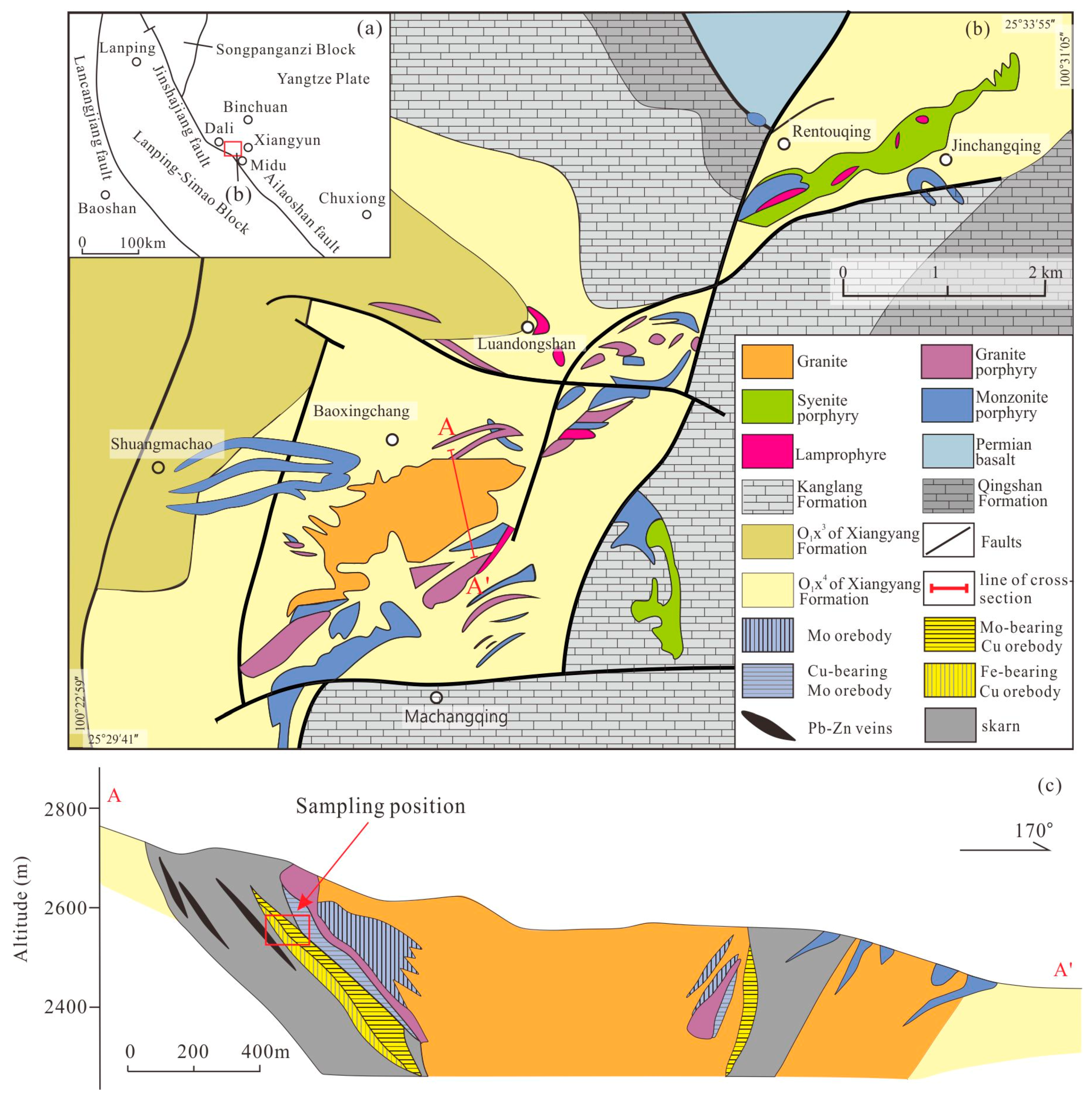
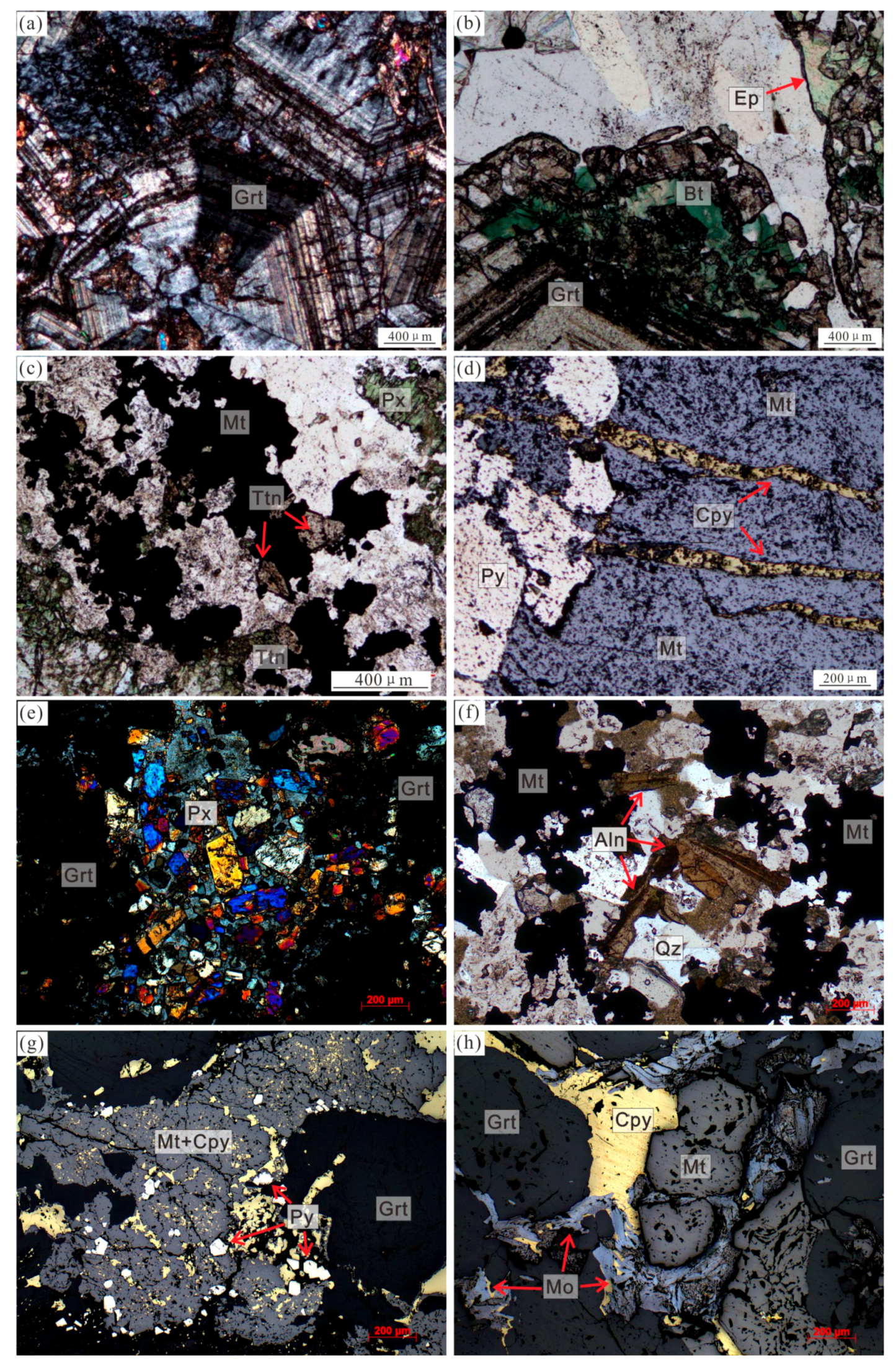
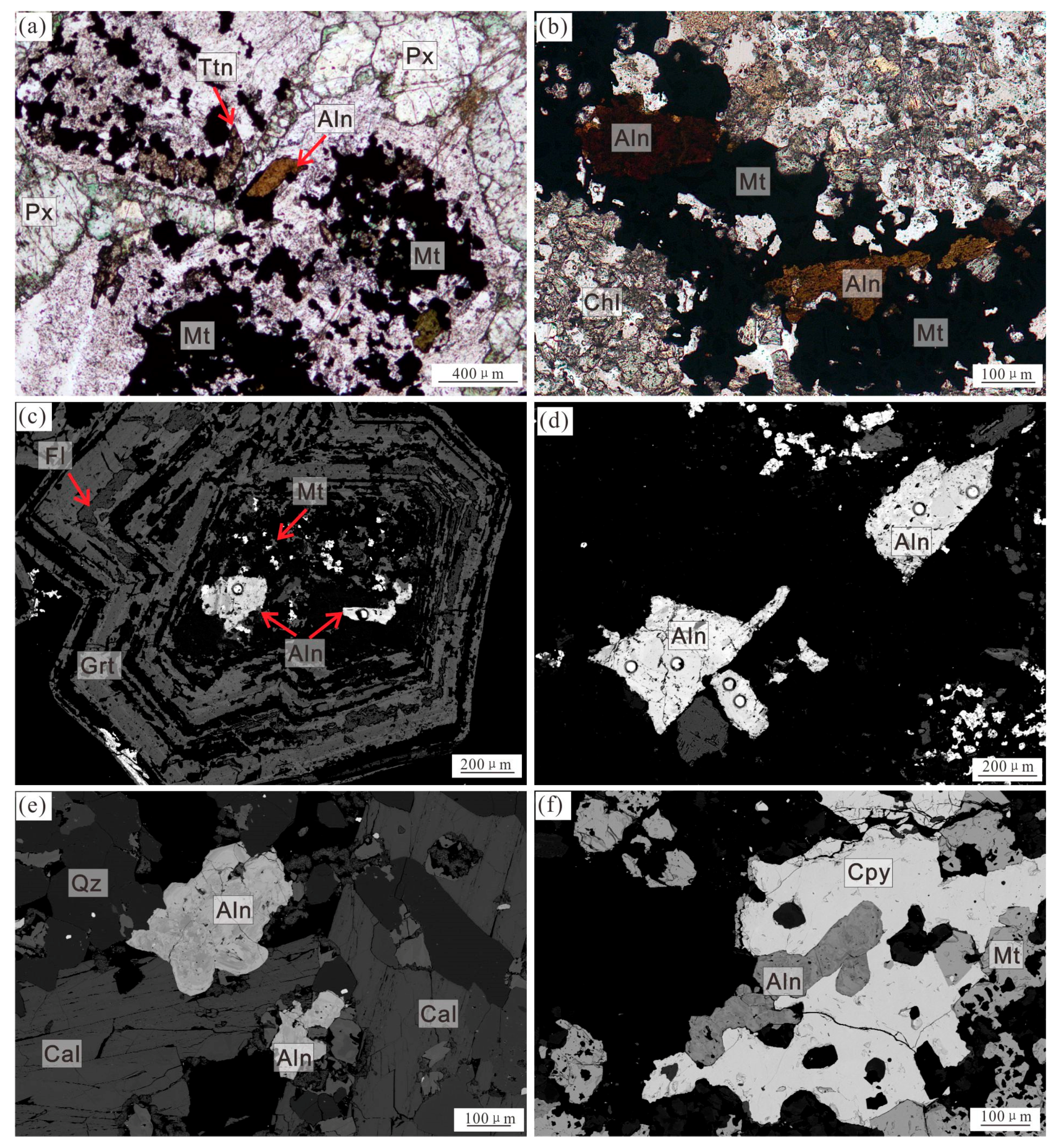
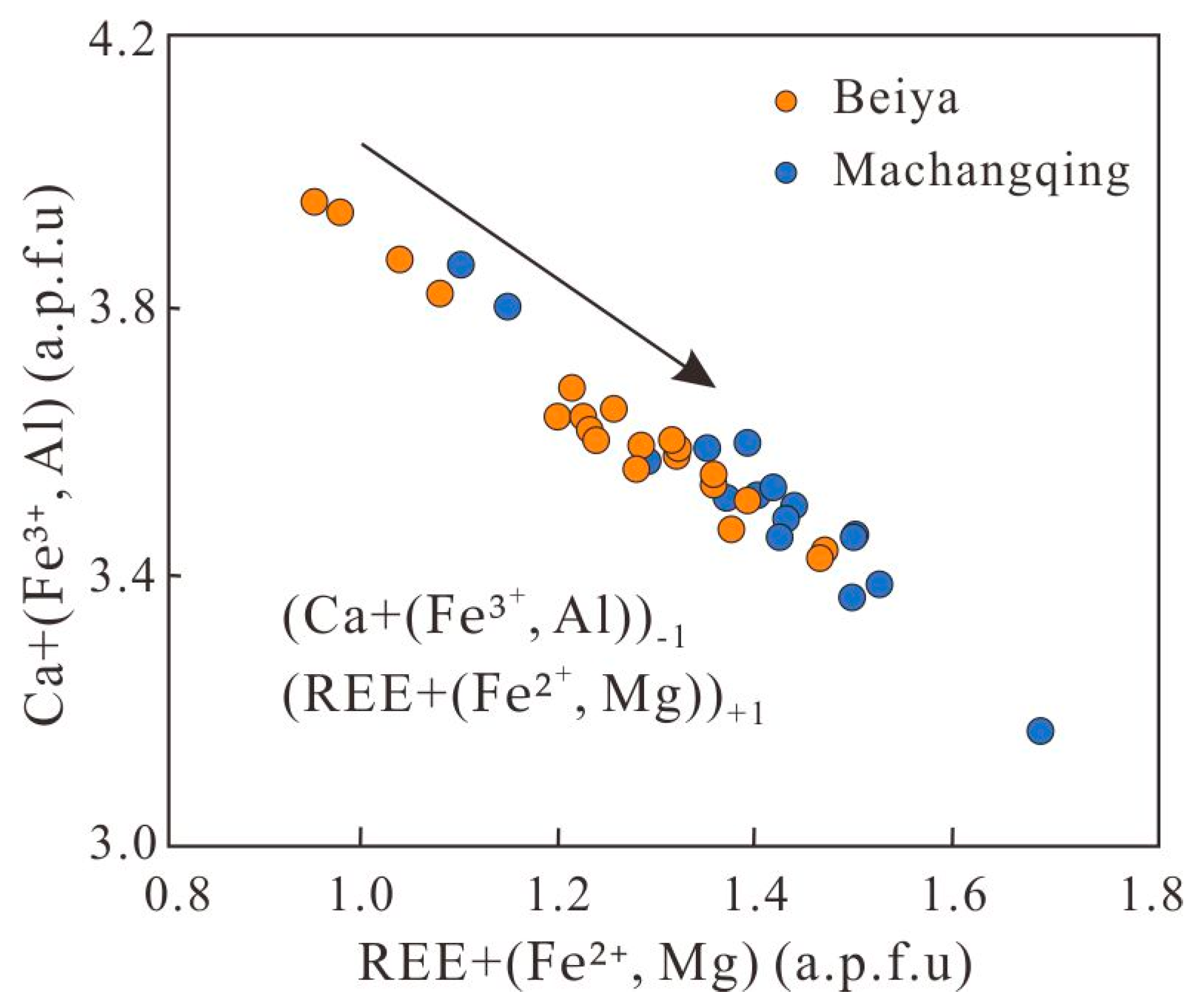
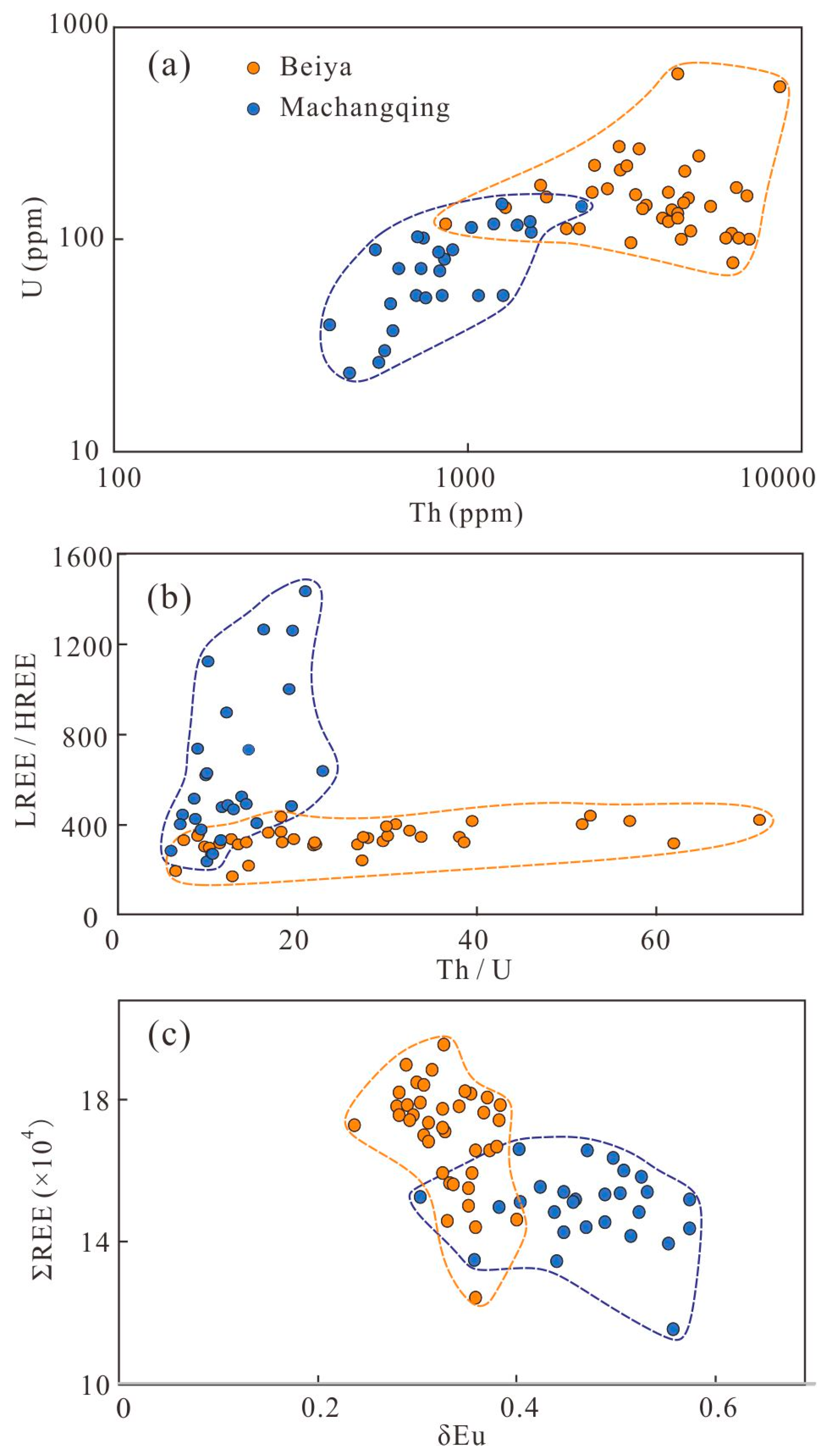
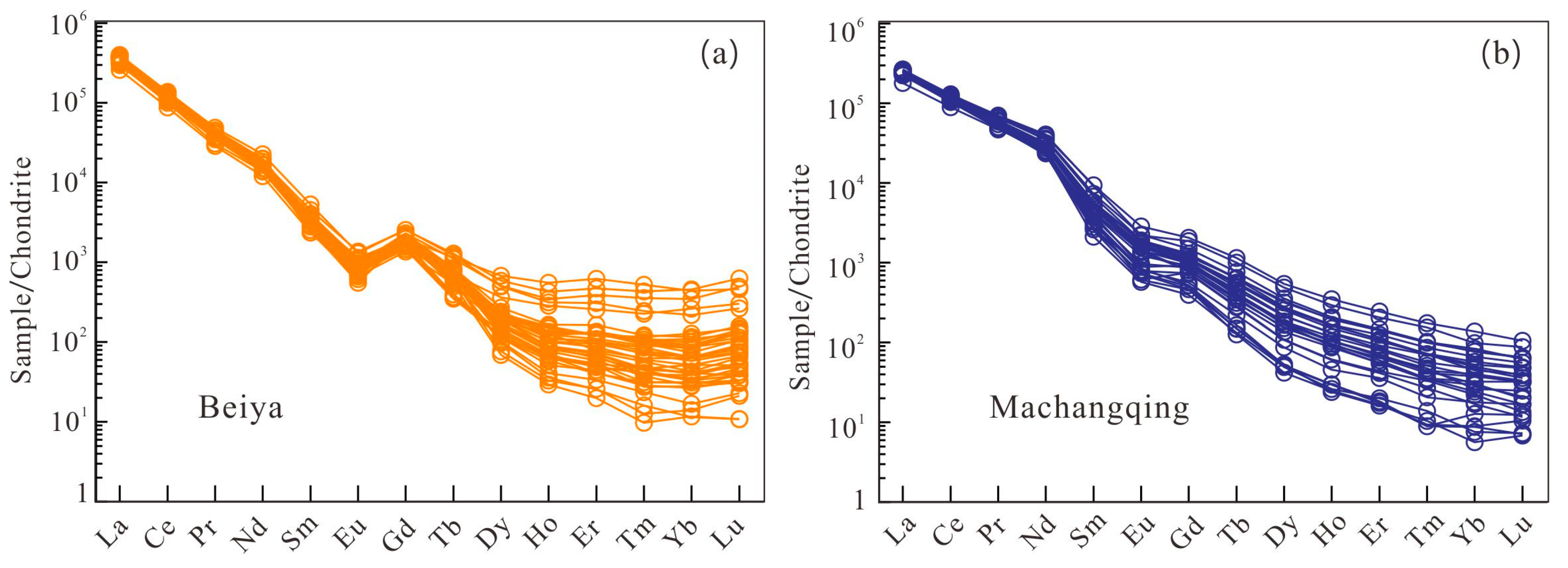
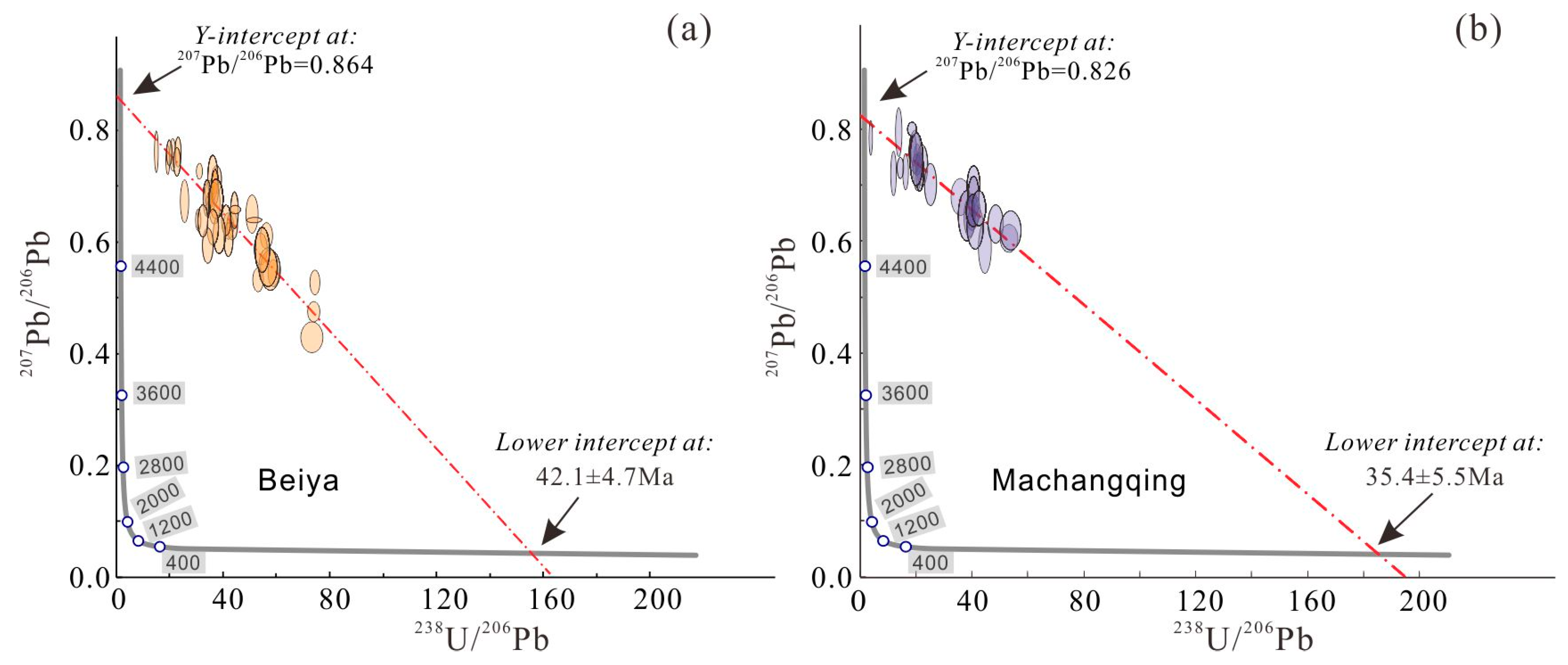
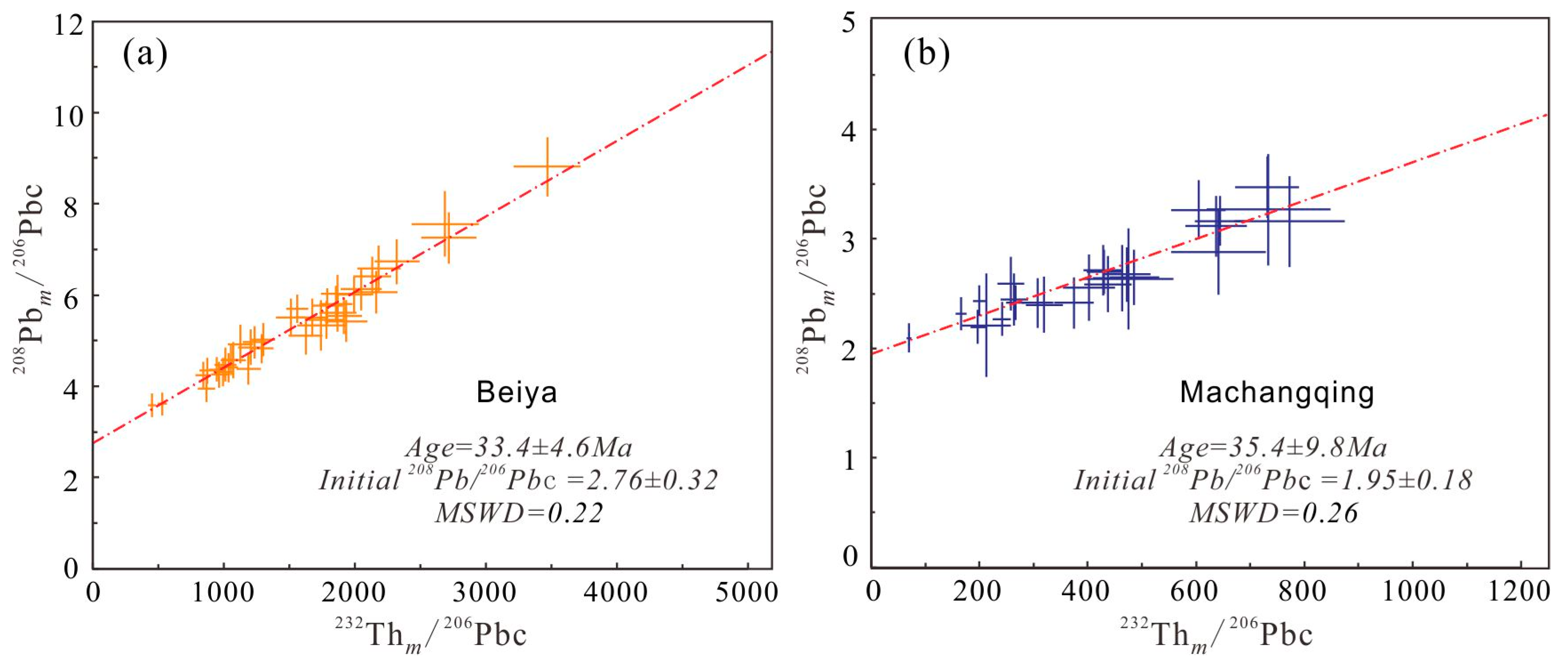
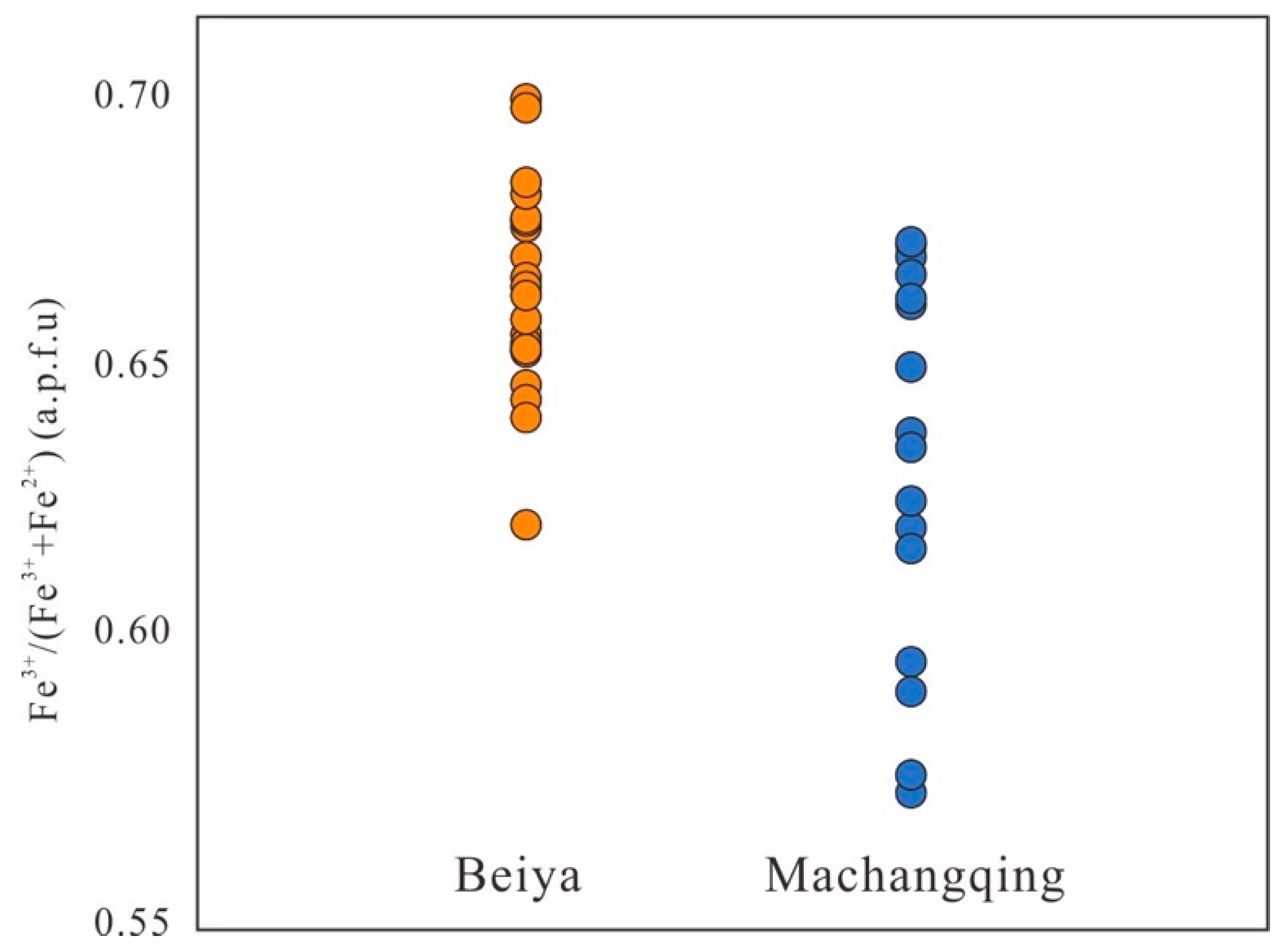
© 2017 by the authors. Licensee MDPI, Basel, Switzerland. This article is an open access article distributed under the terms and conditions of the Creative Commons Attribution (CC BY) license (http://creativecommons.org/licenses/by/4.0/).
Share and Cite
Fu, Y.; Sun, X.; Li, D.; Lin, H.; Lai, C. LA-ICP-MS U-Th-Pb Dating and Trace Element Geochemistry of Allanite: Implications on the Different Skarn Metallogenesis between the Giant Beiya Au and Machangqing Cu-Mo-(Au) Deposits in Yunnan, SW China. Minerals 2017, 7, 251. https://doi.org/10.3390/min7120251
Fu Y, Sun X, Li D, Lin H, Lai C. LA-ICP-MS U-Th-Pb Dating and Trace Element Geochemistry of Allanite: Implications on the Different Skarn Metallogenesis between the Giant Beiya Au and Machangqing Cu-Mo-(Au) Deposits in Yunnan, SW China. Minerals. 2017; 7(12):251. https://doi.org/10.3390/min7120251
Chicago/Turabian StyleFu, Yu, Xiaoming Sun, Dengfeng Li, Hai Lin, and Chunkit Lai. 2017. "LA-ICP-MS U-Th-Pb Dating and Trace Element Geochemistry of Allanite: Implications on the Different Skarn Metallogenesis between the Giant Beiya Au and Machangqing Cu-Mo-(Au) Deposits in Yunnan, SW China" Minerals 7, no. 12: 251. https://doi.org/10.3390/min7120251




